Warcraft Retrospective 36: Battle of the Edgelords
Before we leave Sylvanas behind, let me say just one thing.
Sometimes you hear accusations that Blizzard “ruined” Sylvanas by “turning” her into a villain in later WoW. I don’t think that’s fair to say, since portraying her as a villain is entirely consistent with her portrayal in The Frozen Throne.
She’s evil! She tortures her victim instead of giving him a clean death, she mind controls masses of unwilling people into blind obedience, she lies to Garithos and enters an agreement that she has no intention of honoring, and finally, she orders Garithos killed, unprovoked. The problem is that the campaign is set up so that none of her evil actions (other than mind control) are directed at innocent people; her victims are villains themselves, namely the dreadlords (who may have committed more evil than her), Arthas (who has definitely committed more evil than her), and Garithos (not only evil, considering his readiness to execute all the innocent blood elves, but a massive jerkass to boot). The end result is that when Sylvanas wins, we root for her, even when we recognize deep down that her actions are monstrous.
We’ll see later how this changes in World of Warcraft.
For now we’re returning to Arthas and Anub’arak. Leaving the shores of Northrend behind, they’re ready to descend…
Into the Shadow Web Caverns
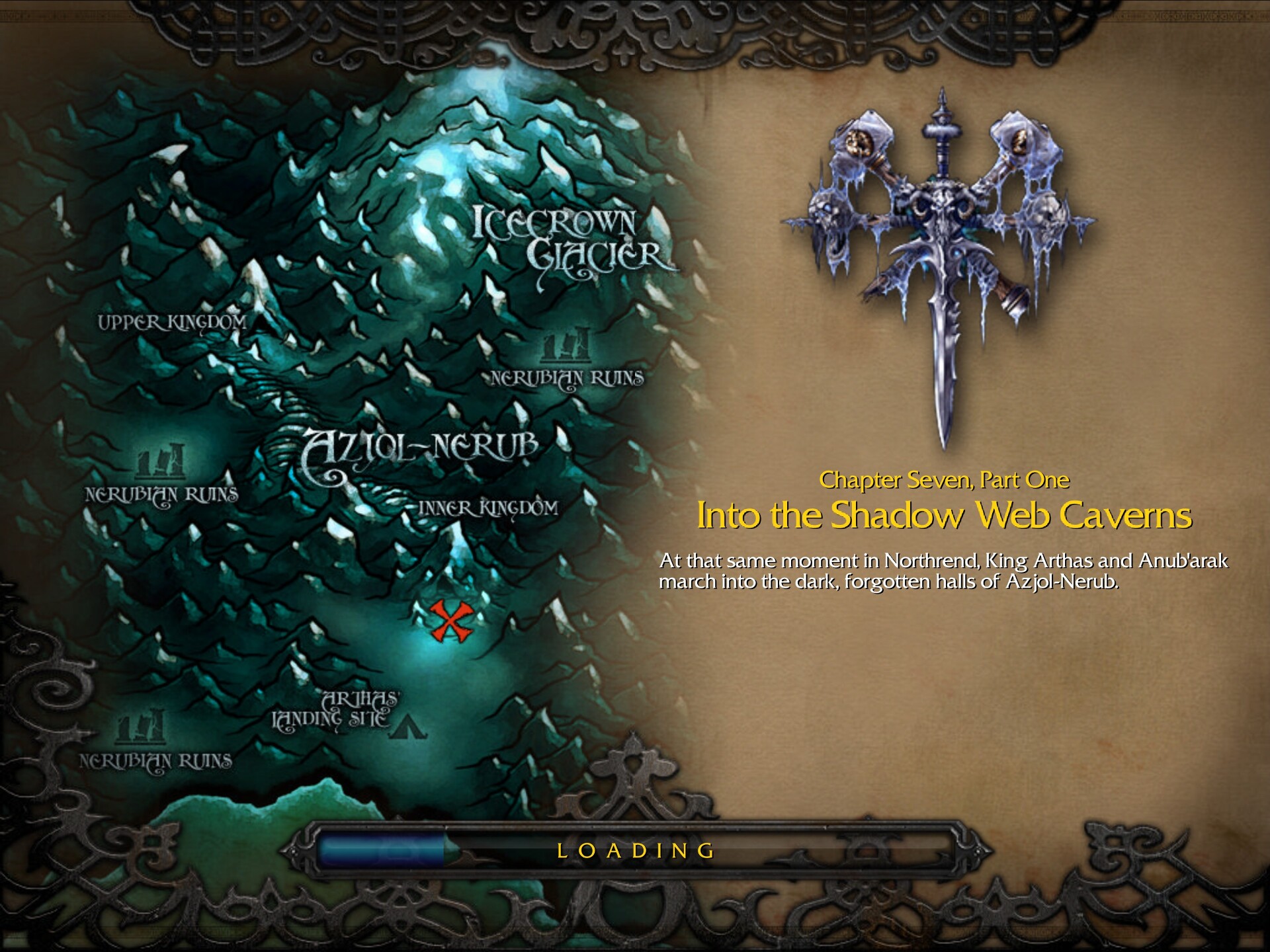
Arthas, Anub’arak, and their undead minions have trekked along the roads of Northrend for hours and have finally reached the gate of Azjol-Nerub. Arthas wonders where all the nerubians are, undead or otherwise. Anub’arak is puzzled by their absence and believes something must have driven them off.
That “something” turns out to be a bunch of Muradin’s dwarves!
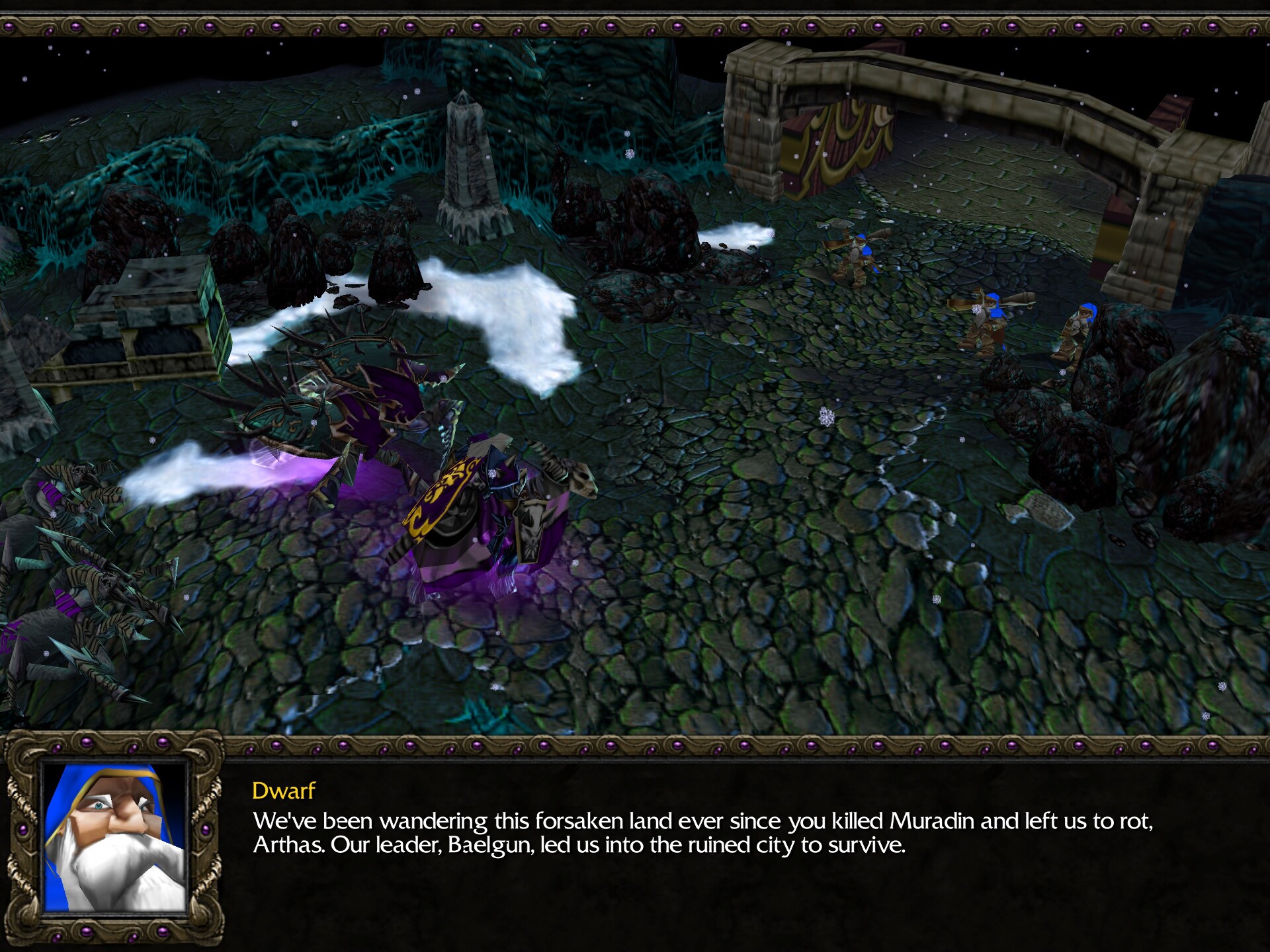
Having “no time for these games”, Arthas sics Sapphiron on them. The dwarves try to close the gate (painted in elven style for some reason), but the frost wyrm shatters it. However, that’s as far as we’ll be able to take him.
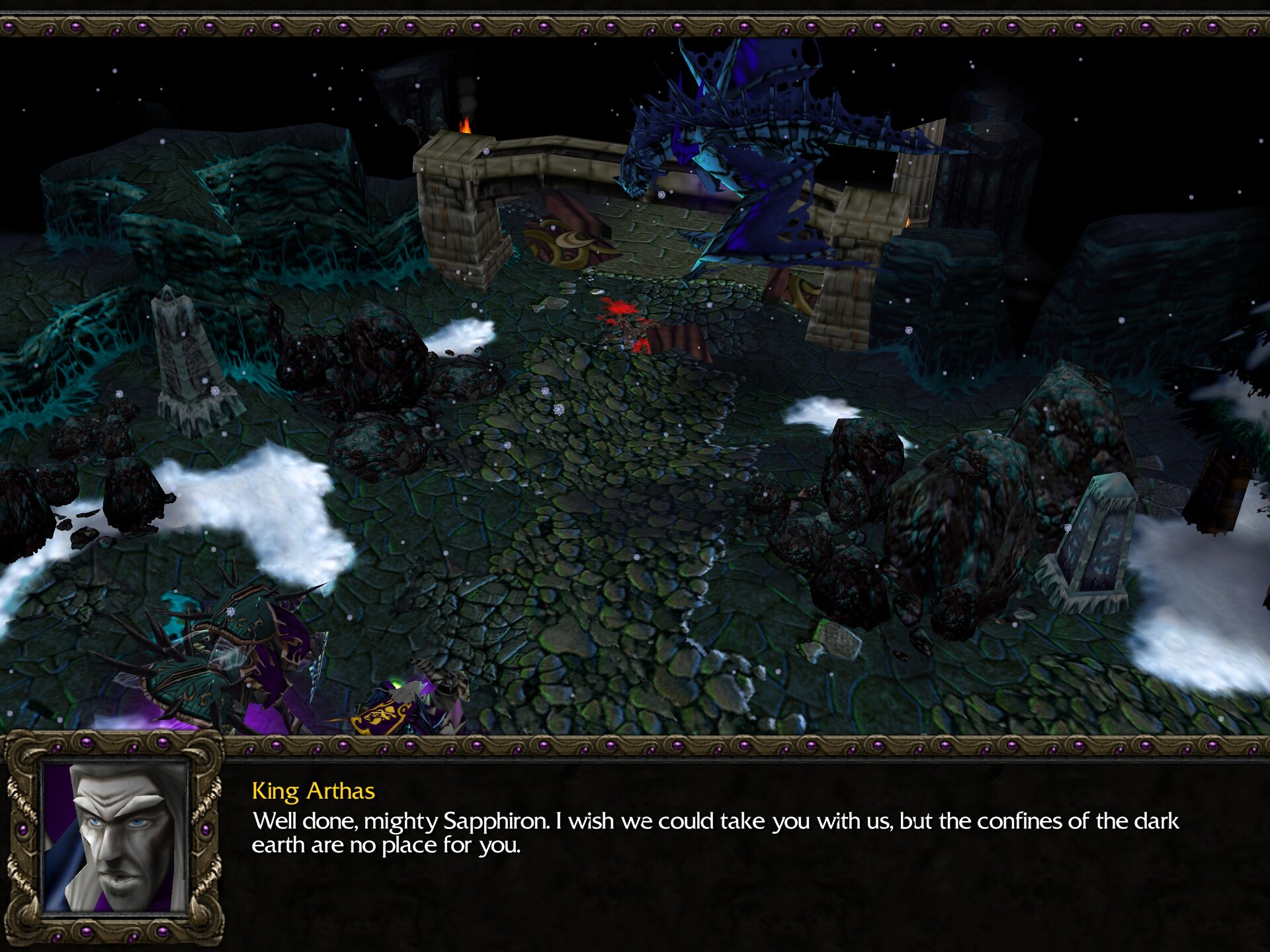
No overpowered unit for us, then. We’ll have to proceed into Azjol-Nerub with some ghouls, crypt fiends, and a single meat wagon.
The mission begins with an antepiece. We reach a chasm filled with water and cannot cross through. There’s a lever on the other side next to some explosive barrels, and to cross, we have to order our meat wagon to attack the lever — which will also ignite the barrels. This teaches you, in one swoop, that these levers can manipulate raised and lowered platforms, and that explosive barrels can be destroyed.
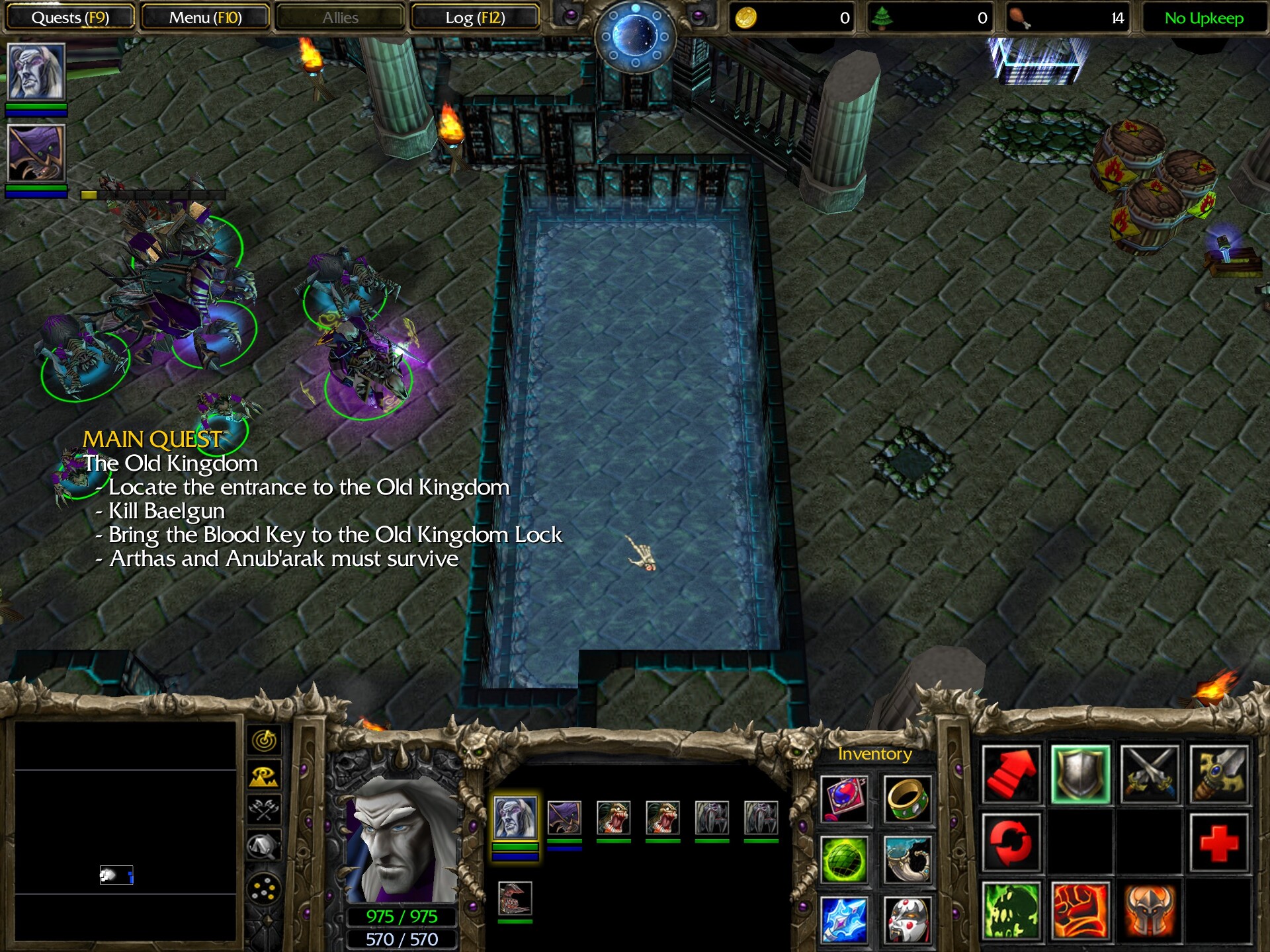
Next we reach a bridge loaded to the brim with explosive barrels. To prevent Arthas and company from crossing through, the dwarves in front of the bridge blow the barrels up — which destroys the bridge and blows them up, too.
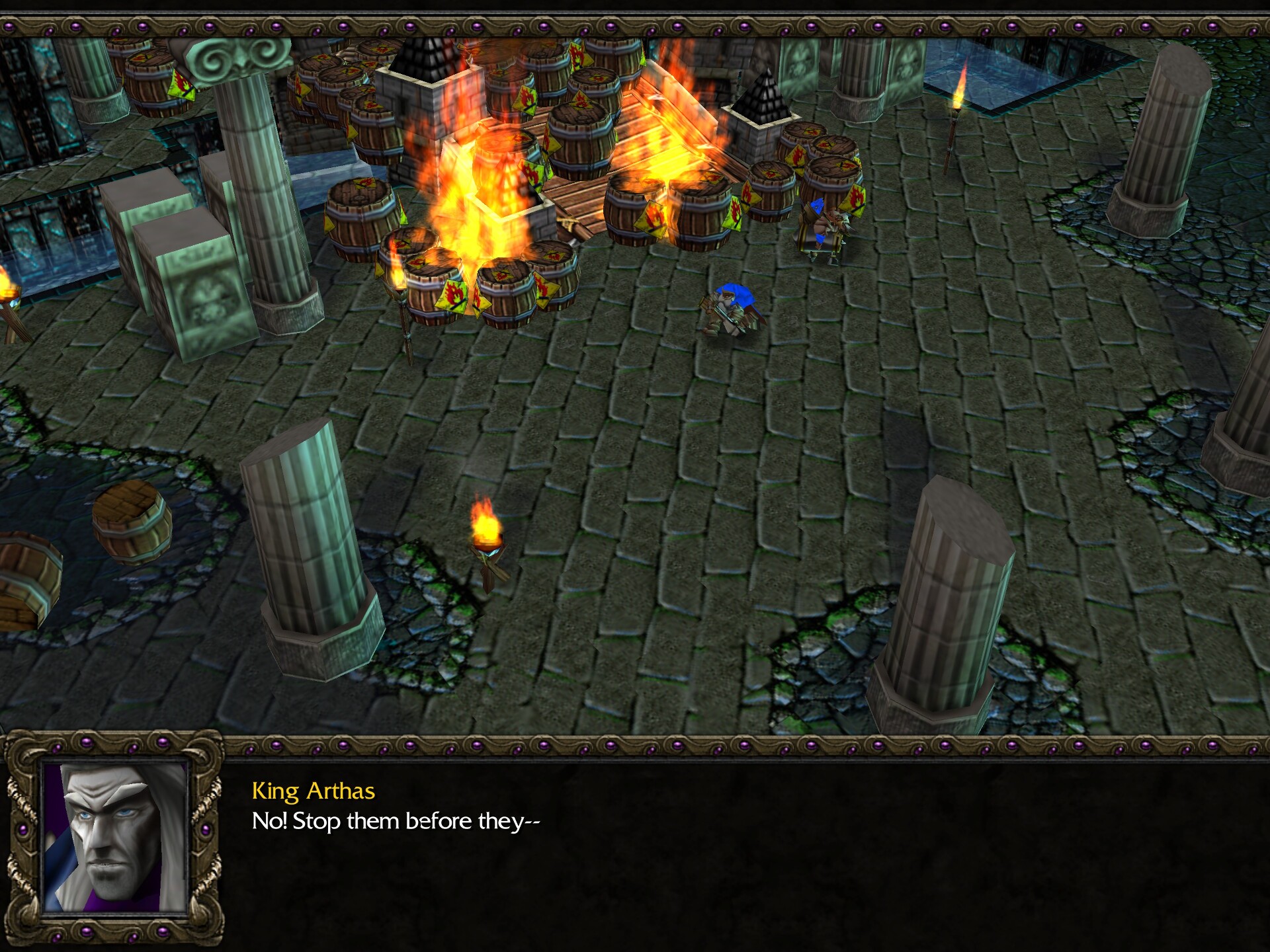
Okay, I have questions.
I’m not asking why these dwarves put so many explosive barrels on this one bridge, presumably just in case unforeseen undead visitors would attempt to cross over.
I’m not asking why this entire cavern is filled to the brim with explosive barrels in such big numbers. Maybe some fool ordered 100,000 of them.
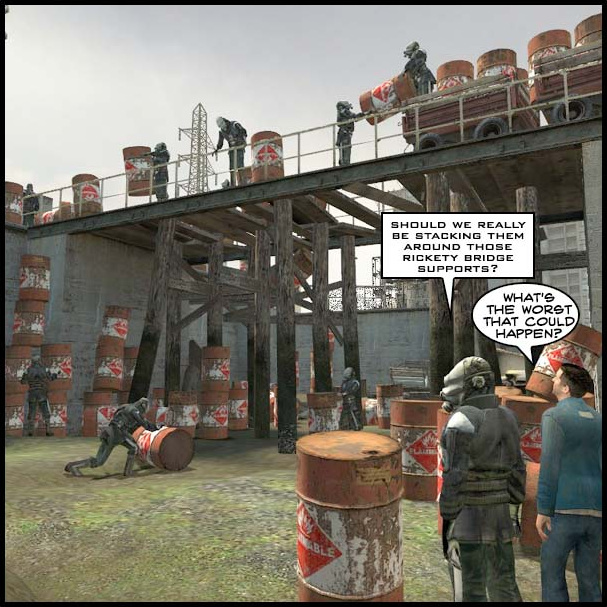
No, what I’m interested in is how they made all these barrels in the first place. And for that matter, what do they eat? Tolkienesque fantasy overall tends to sidestep the question of where dwarves get their food in their subterranean caverns1, but these dwarves are in a particularly unenviable situation where they have been sitting here for months, in caverns built by spider people for spider people, with no existing infrastructure they could rely on, with little in terms of agriculture or hunting, and with nobody to trade with. Yet somehow not only haven’t they starved yet, but they seem to have a functional enough military-industrial complex that they could make all these barrels?
Whatever. We navigate the underground halls, blowing up all explosive barrels that stand in the way and letting them kill the dwarves for us. Along the way, we find a cache of gold, and Arthas takes note of it.
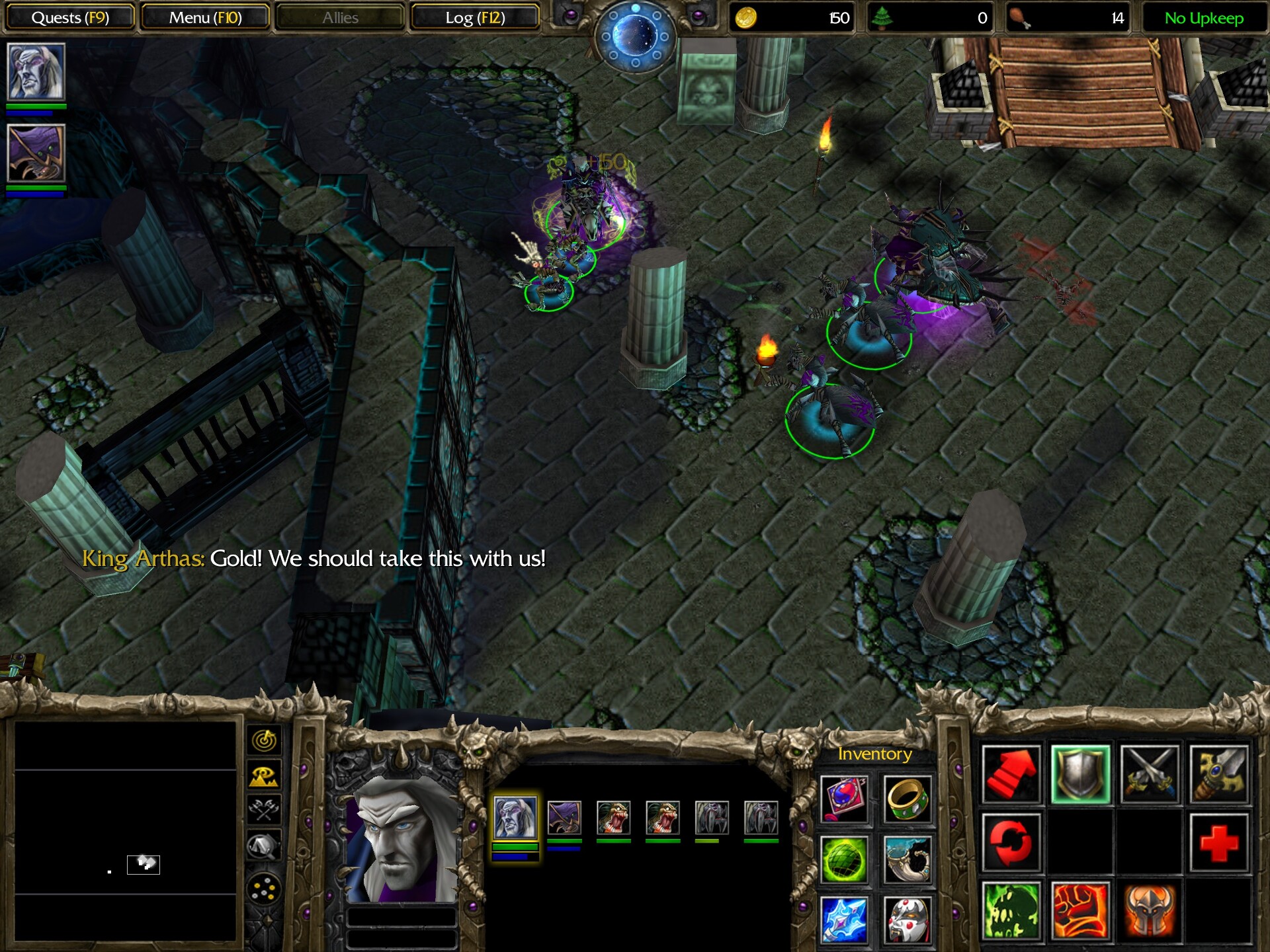
Apparently Arthas has suddenly become afflicted by dragon-sickness, because every time we come across some gold, he comments on it. Oh look, gold! Here’s more gold! We should take it with us! Since we don’t have any means to spend it yet, it feels like greed for greed’s sake.
Eventually we leave the halls behind and enter some caves filled with hostile nerubians and their webs and eggs. Arthas asks a rather strange question.
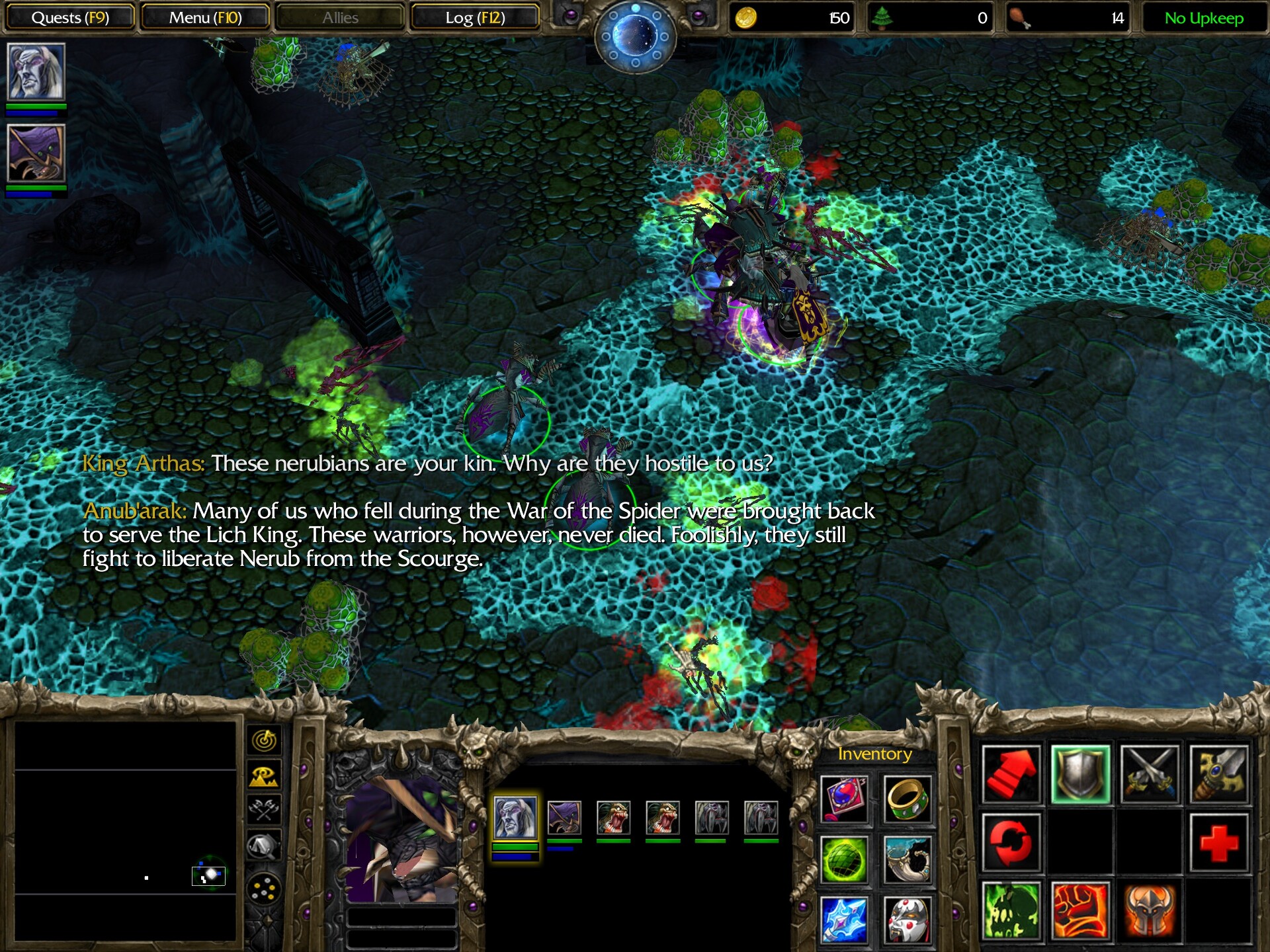
Since at least the Quel’Thalas missions, when he first deployed crypt fiends, Arthas knows that the Lich King subjugated Azjol-Nerub and raised its denizens into undeath against their will. It seems obvious, then, that any still-living nerubians — like the ones we meet here — will be opposed to the Scourge.
Next we loot a storage silo, disarming a spike trap, and keep navigating dwarf-filled corridors, blowing up all explosive barrels in sight.
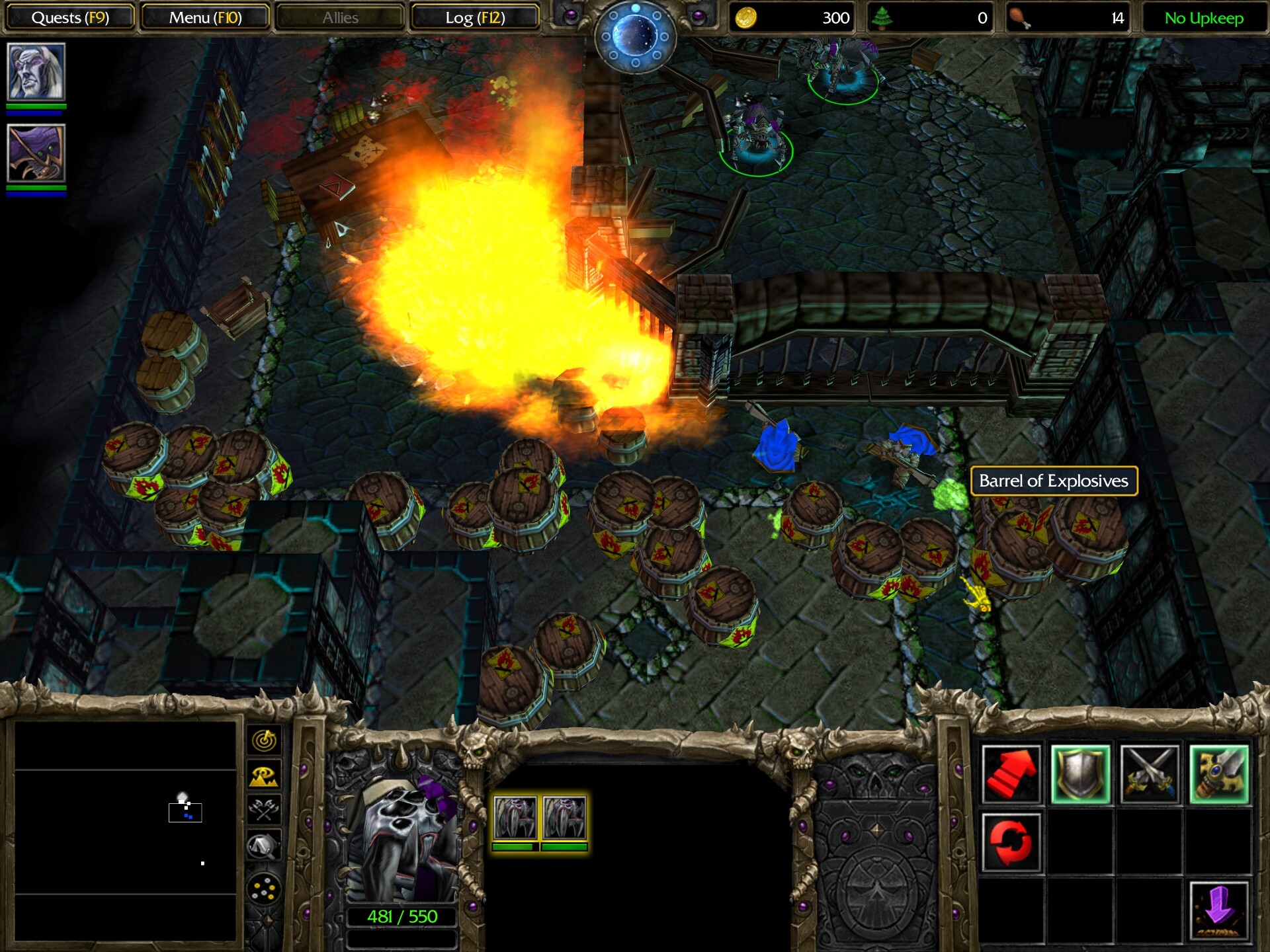
Eventually we reach Baelgun himself. He remembers Arthas, calling him “traitor”. He explains that the latest quake awakened some “ancient, horrid things” under the ice, and the dwarves vowed to keep them locked — and so they will.
As a level 10 mountain king, Baelgun is a tough challenge for Arthas and Anub’arak, both level 5! He can deal massive damage with Storm Bolt, stun enemies with Thunder Clap, and assume a supercharged form with Avatar. It was challenging even with an item to summon a felstalker at my side.
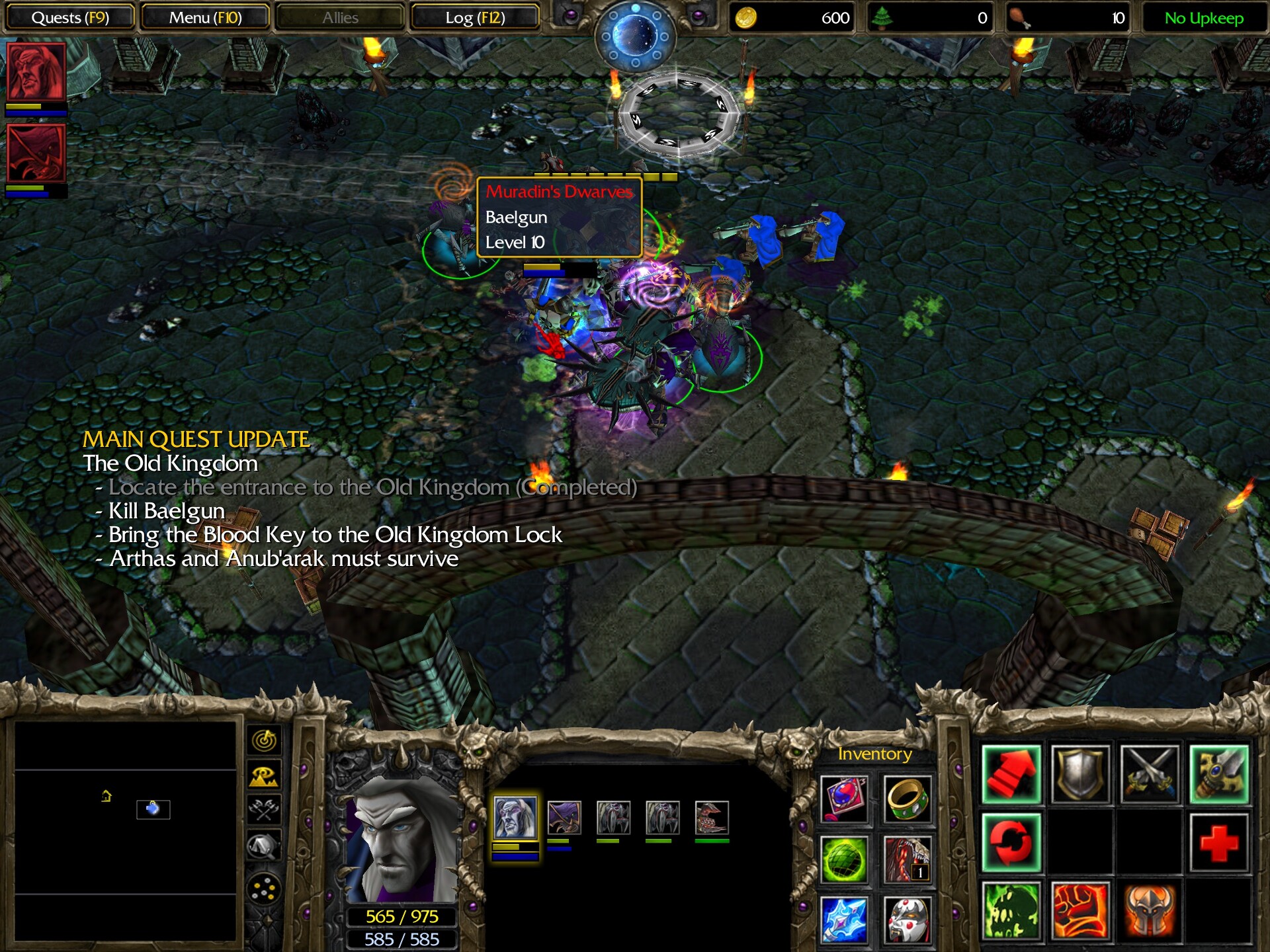
Still, he goes down and drops the Blood Key, with which we open the door. We’re now ready to descend deeper into Azjol-Nerub, where unseen horrors await.
The Forgotten Ones
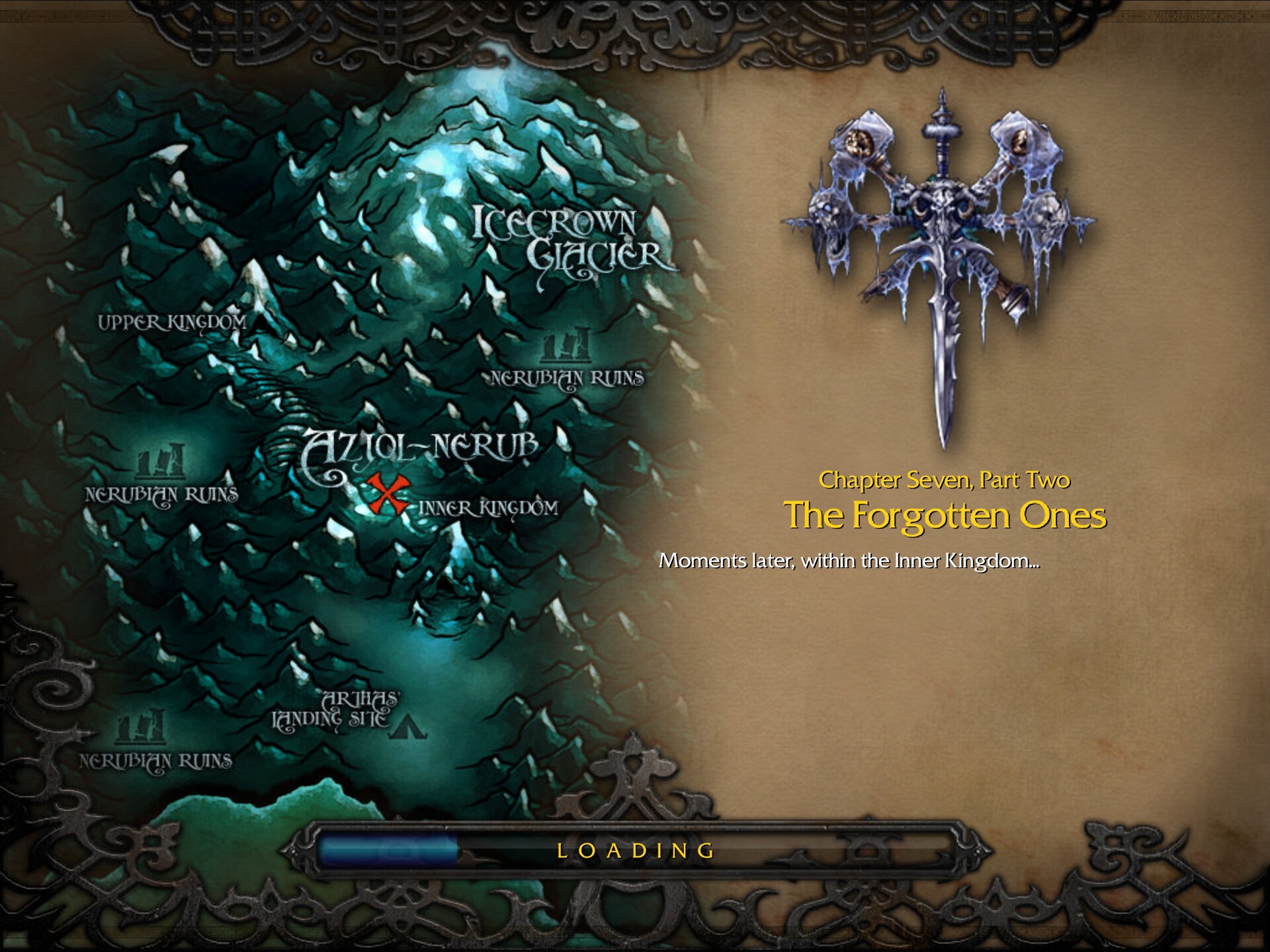
Arthas and Anub’arak’s dynamics throughout these missions are resembling an hourglass. With every mission, Arthas drops a level; last mission he was level 5, now he’s level 4. Anub’arak, meanwhile, is gaining levels, and it’s getting more and more imperative to put him on the frontlines while a progressively squishier Arthas stays at the back during the most intense fights.
If the last mission’s theme was dwarves and explosive barrels, the theme of the first part of this mission is traps. It begins with a long hallway with a line of towers on each side.
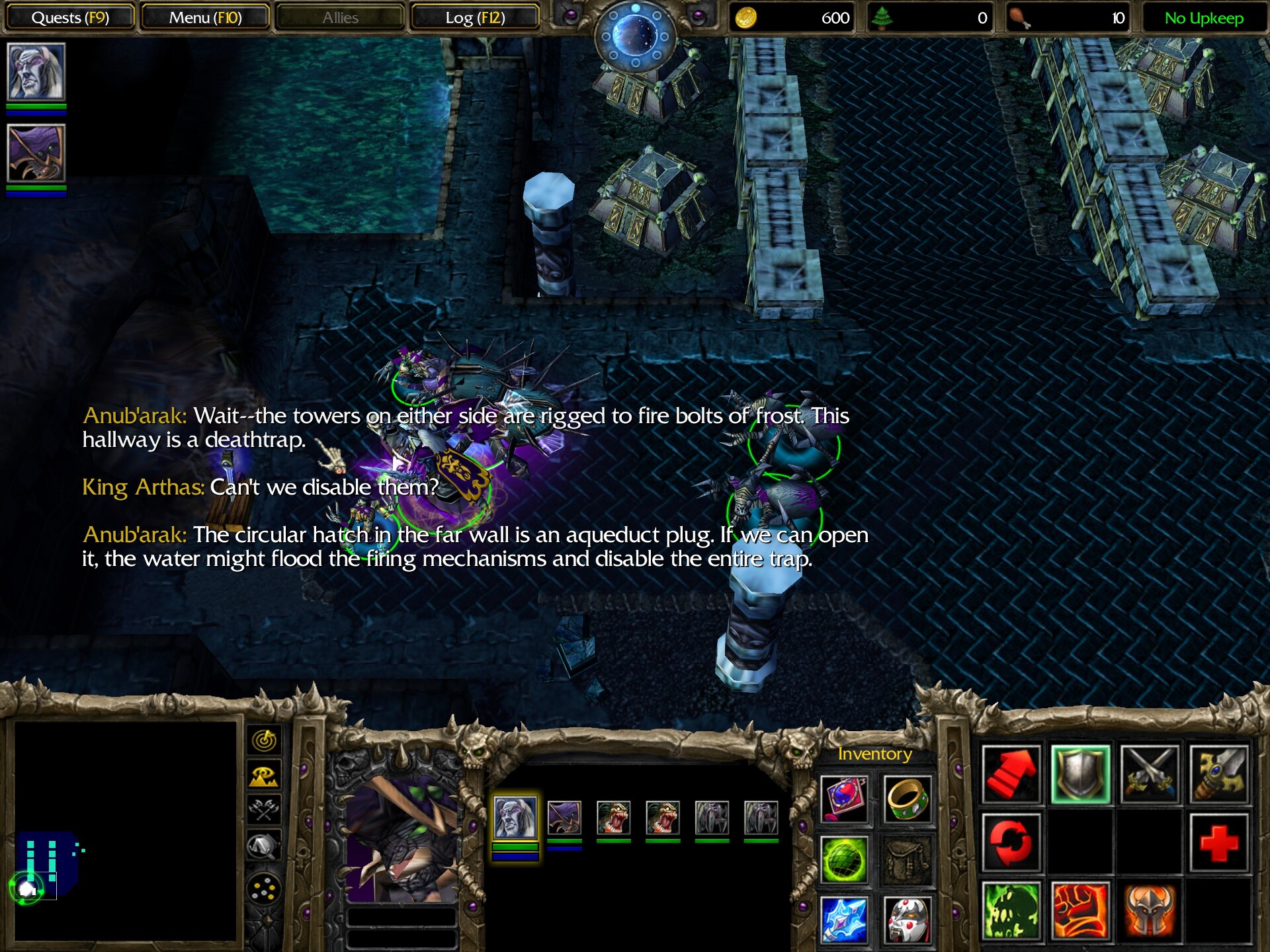
One of the levers is just hidden under some rock chunks, so it’s likely the player will find it before Anub’arak finishes explaining the design of the trap. The lever on the other side, however, is guarded by some nerubians.
In the next room, there’s an amusing exchange as the nerubians mention “the traitor king” and Arthas believes they’re referring to him, when they actually mean Anub’arak.
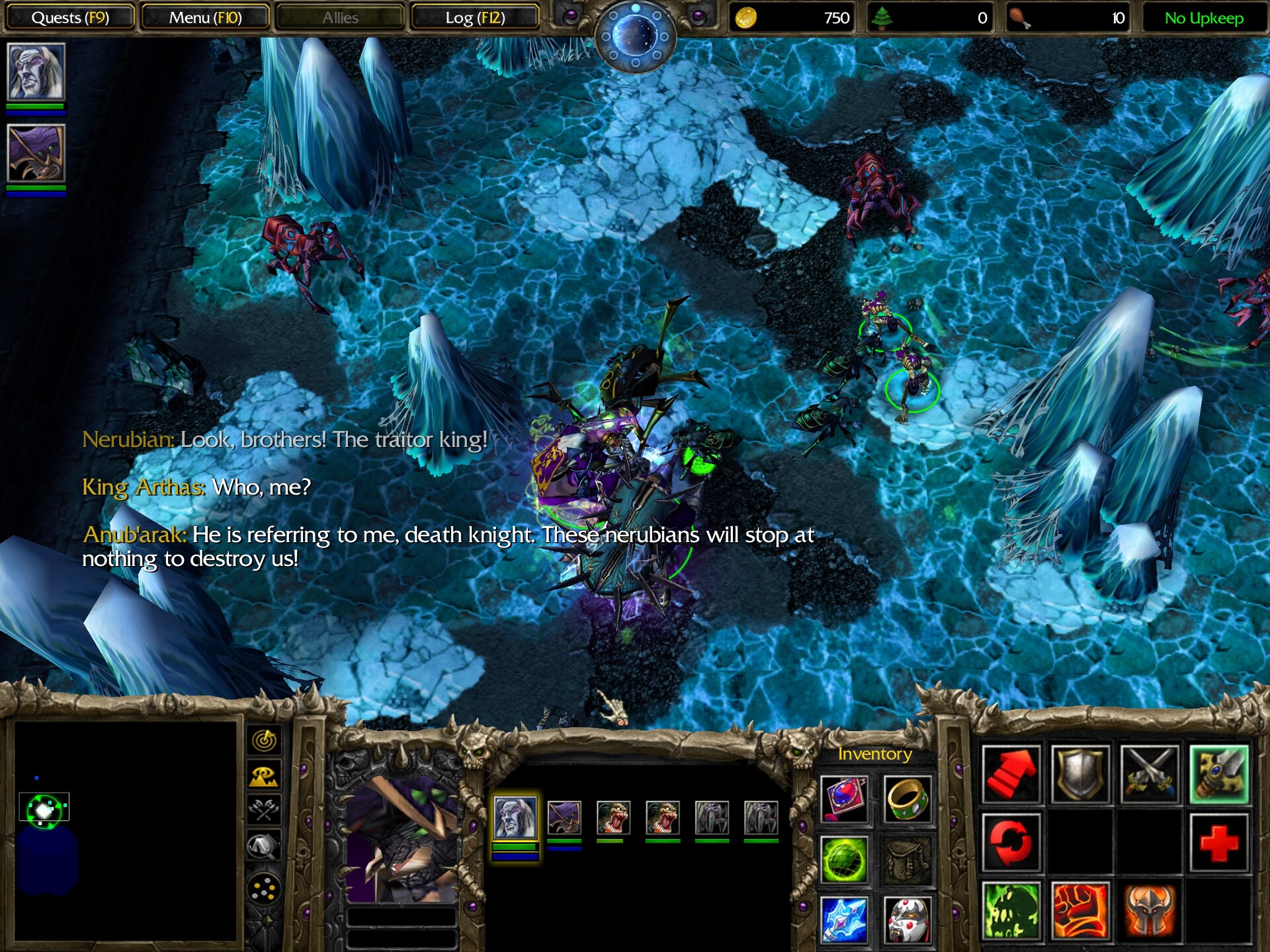
The living nerubians are holding a crypt fiend captive, and once freed, he mentions that more of his comrades are captured in the rooms ahead. I don’t really know why the living nerubians bothered to imprison them instead of just slaying them like the undead mockeries of life they are, but it works in our favor.
Next is a raised platform that, when stood on, falls into water full of crabs.2 Then a pedestal holding a Belt of Giant Strength +6 that, when collected, releases a swarm of scorpions. Finally, there’s a room that continuously spawns hatchlings until the doors to the rooms they spawn in are closed. We find where the other crypt fiends are imprisoned and free them. Now we have a sizable force.
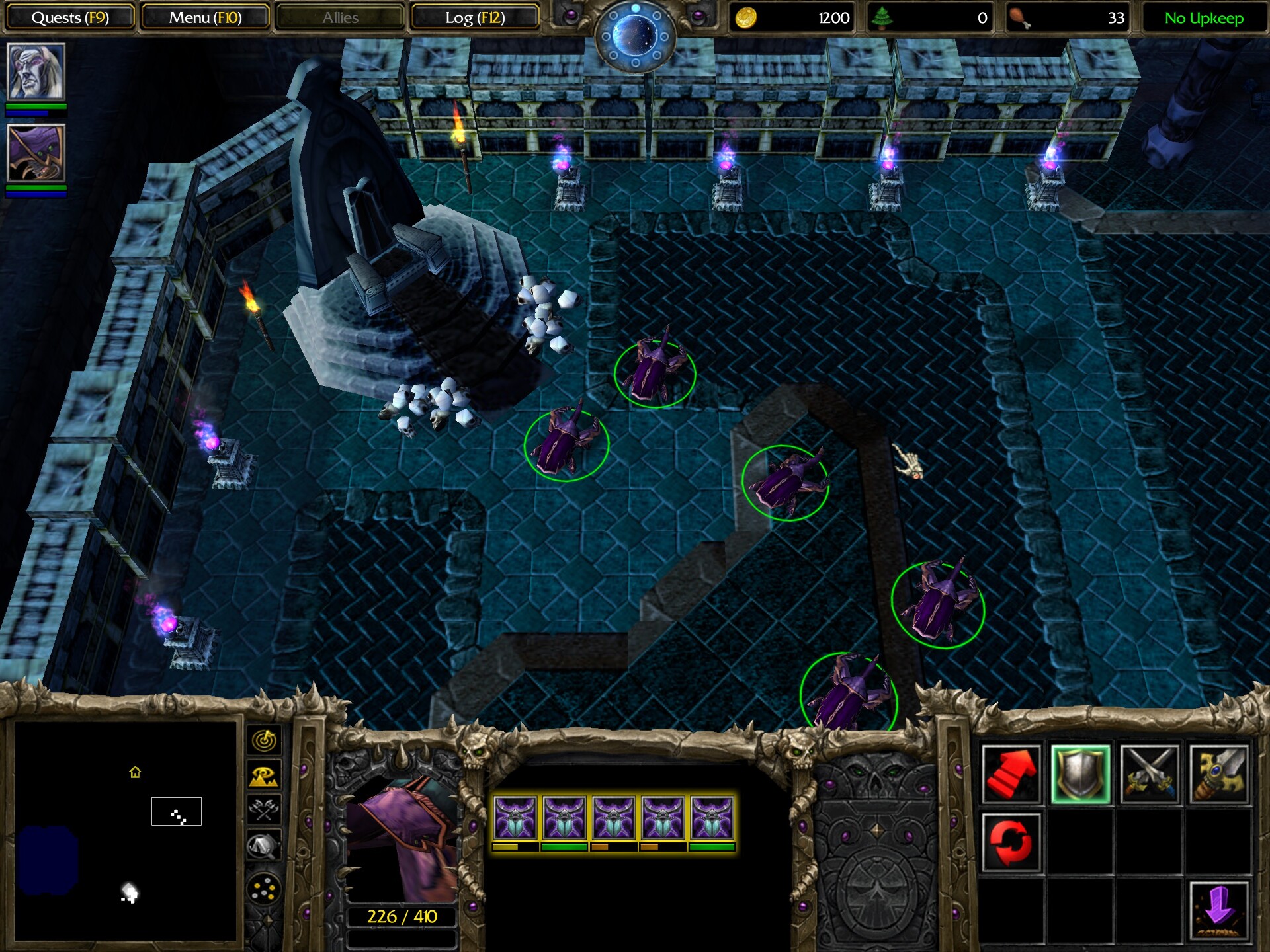
Eventually we reach a hall filled with tentacles and… tentacled humanoid monsters? Arthas asks what they are.
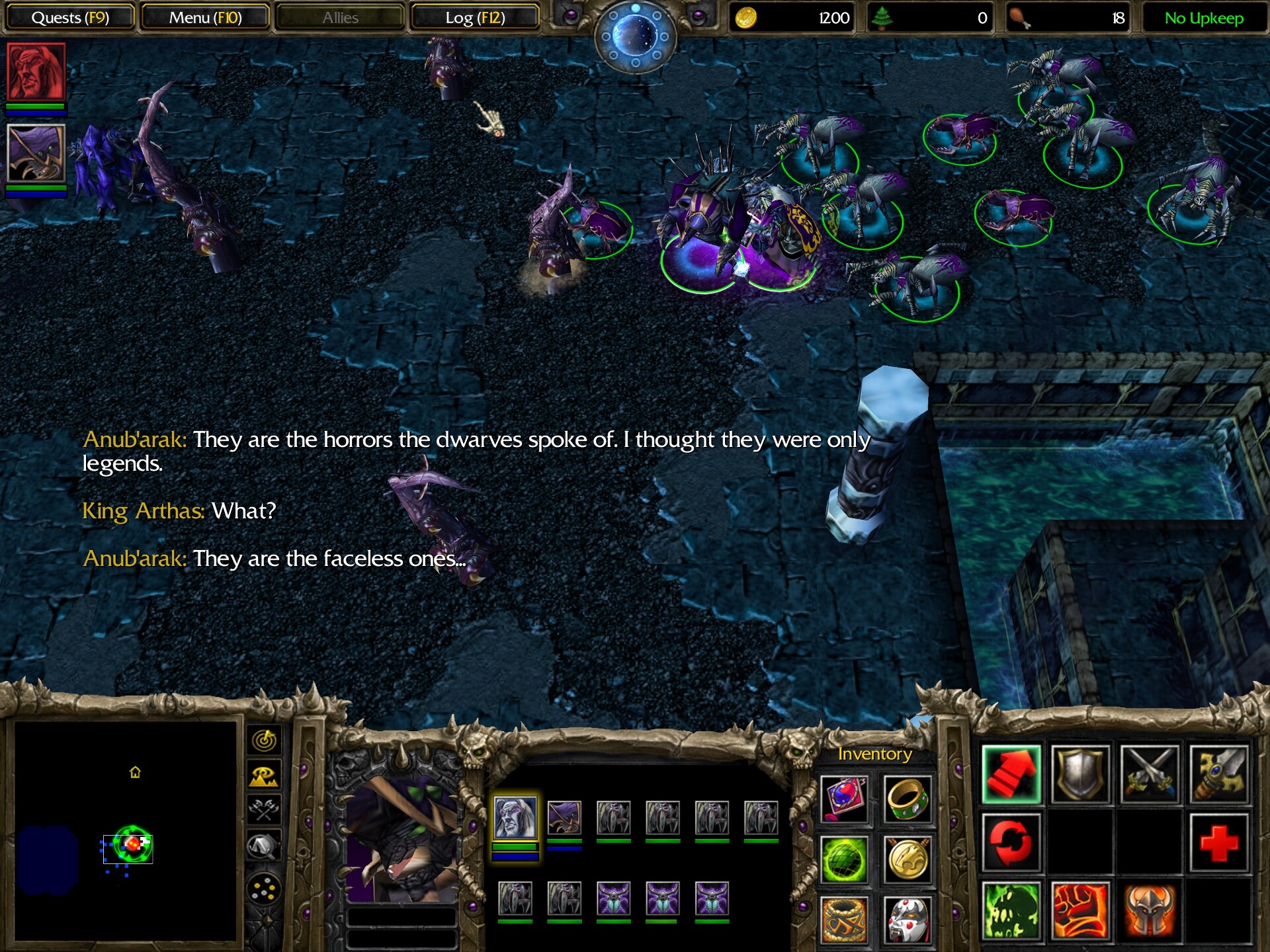
So on top of everything else, Warcraft now has some Lovecraft, or more precisely Lovecraft-lite since they’re just monsters to be fought, not signs of total cosmic nihilism and despair. They are faceless ones, and their inclusion in TFT is just momentary indulgence in worldbuilding and setting up threads for World of Warcraft to follow; we’re going to wait until WoW to find out exactly what they are or whom they serve.
Having fought through the faceless ones, we reach the chamber of the final boss of this mission — whatever this is.

This is the Forgotten One, and to my knowledge, it’s the only known creature of its kind in all of Warcraft. It even has a short introductory cutscene to highlight what a menace it is, but honestly, compared to Baelgun, it’s a pushover. Though it has a massive HP pool, we have like twelve crypt fiends at this point, and we defeat it before it (somehow) spawns too many tentacles through the stone floor.
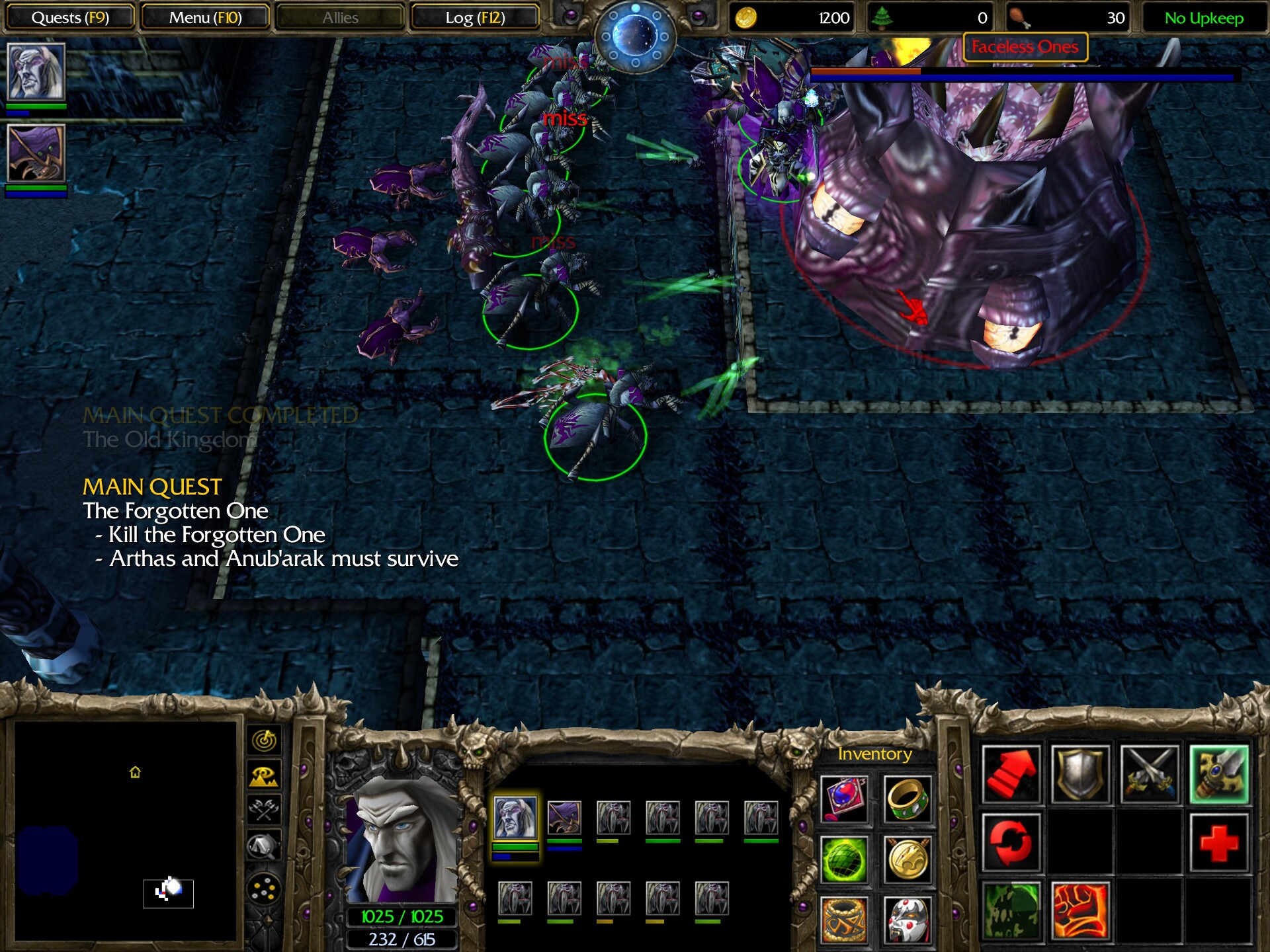
However, with the Forgotten One’s death, more faceless ones emerge through a newly opened door. We can’t take them all, so Anub’arak calls for Arthas to go up the stairwell, beginning their…
Ascent to the Upper Kingdom
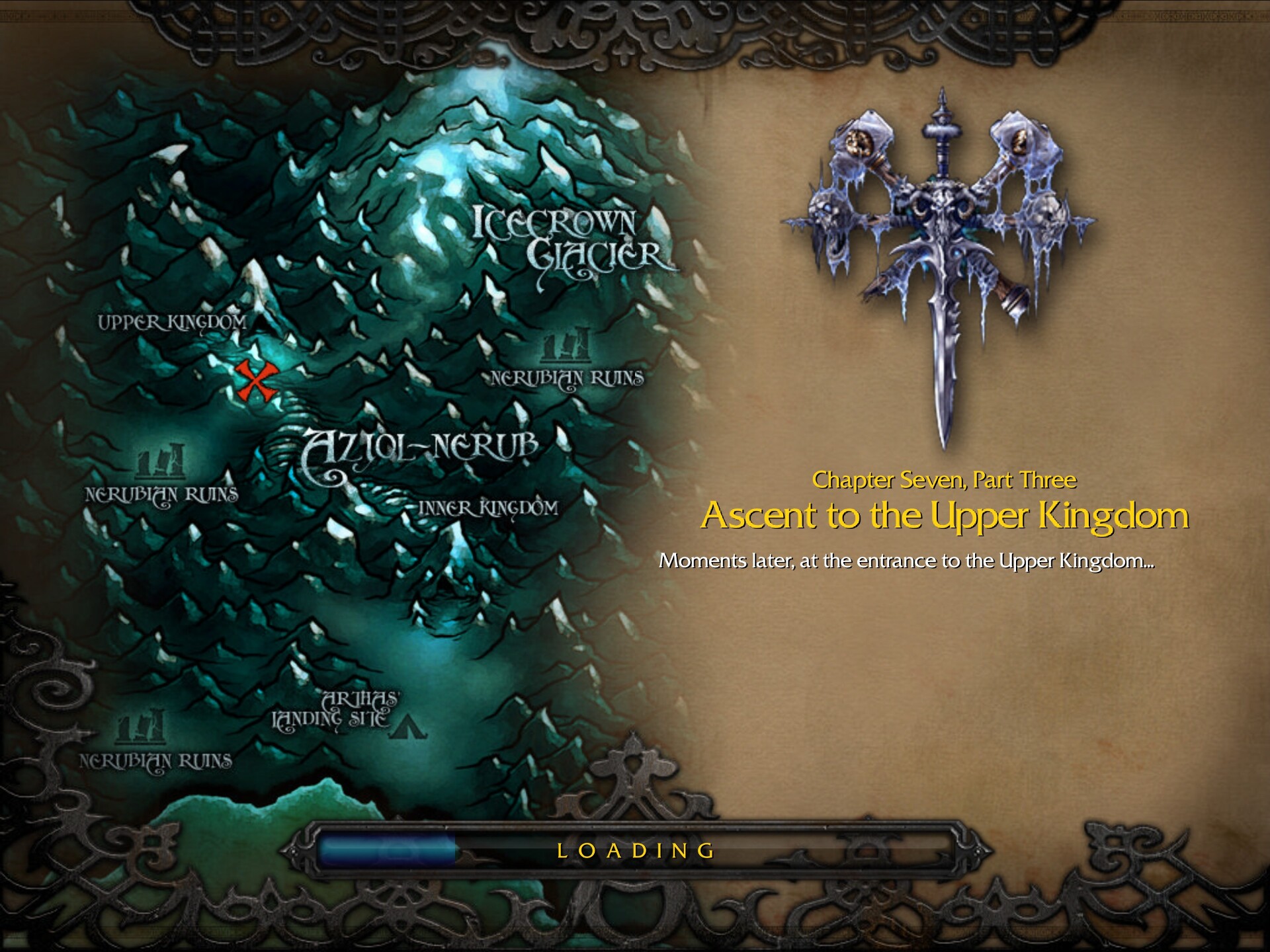
As we reach the Upper Kingdom, a sudden cave-in separates Arthas from Anub’arak and their minions.3 Now we’re left controlling a level 3 Arthas and have only ten minutes to complete this entire mission, our goal being to escape the cavern before it collapses. Along the way, Arthas faces a variety of traps. First there’s a relatively easy timing trap with flames bursting out of the sides of a narrow passage, then there’s a harder one where there are a few islands of safety strewn across a floor where flames periodically appear and disappear.
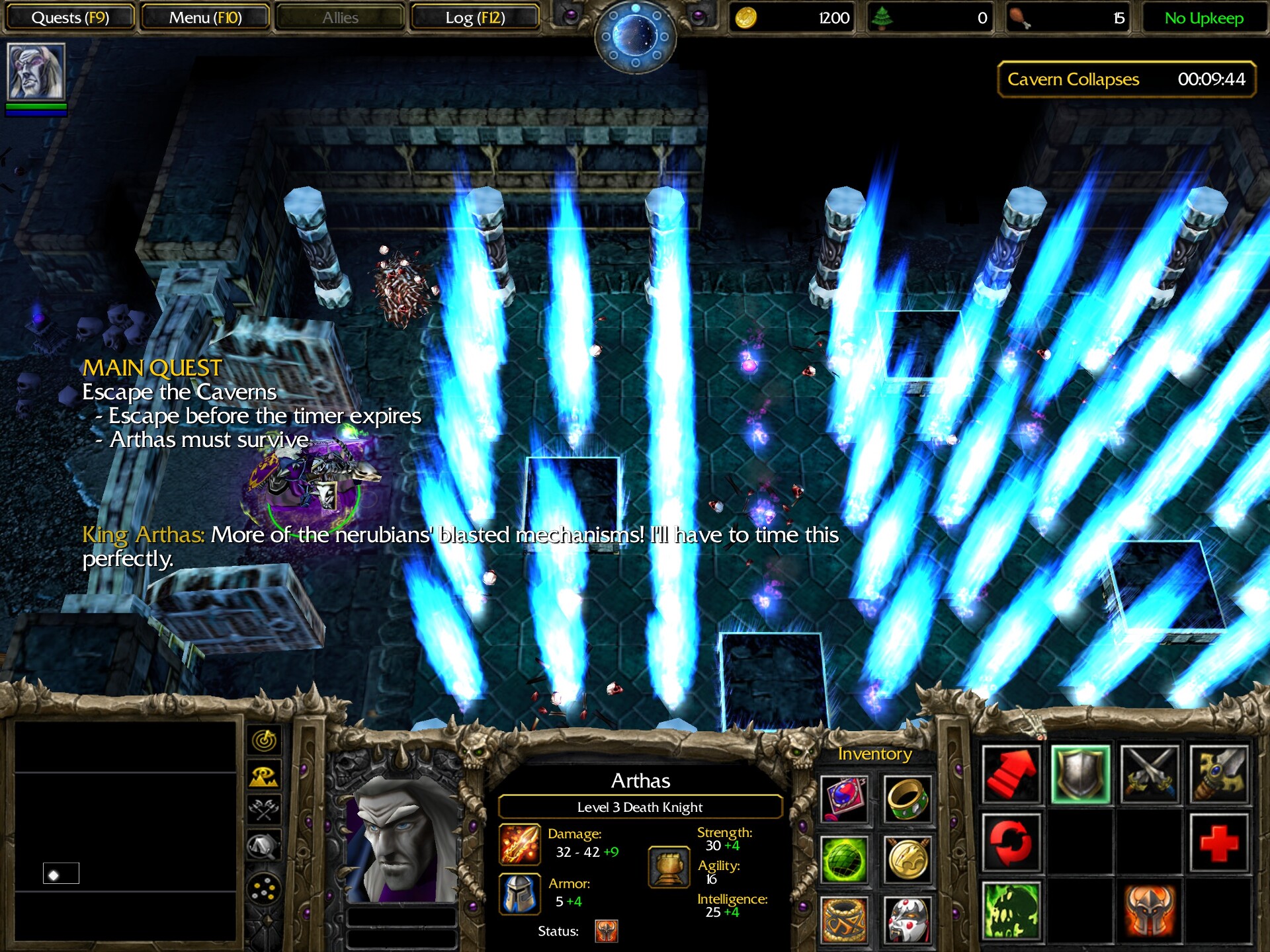
Thankfully, there’s a Fountain of Health right after this one, and it’s hypercharged, healing Arthas much faster than a normal Fountain of Health would. Then there’s a trap consisting of a series of barriers we need to destroy while a faceless one casts Blizzard at us, and then another trap consisting of platforms periodically rising and lowering themselves over water.
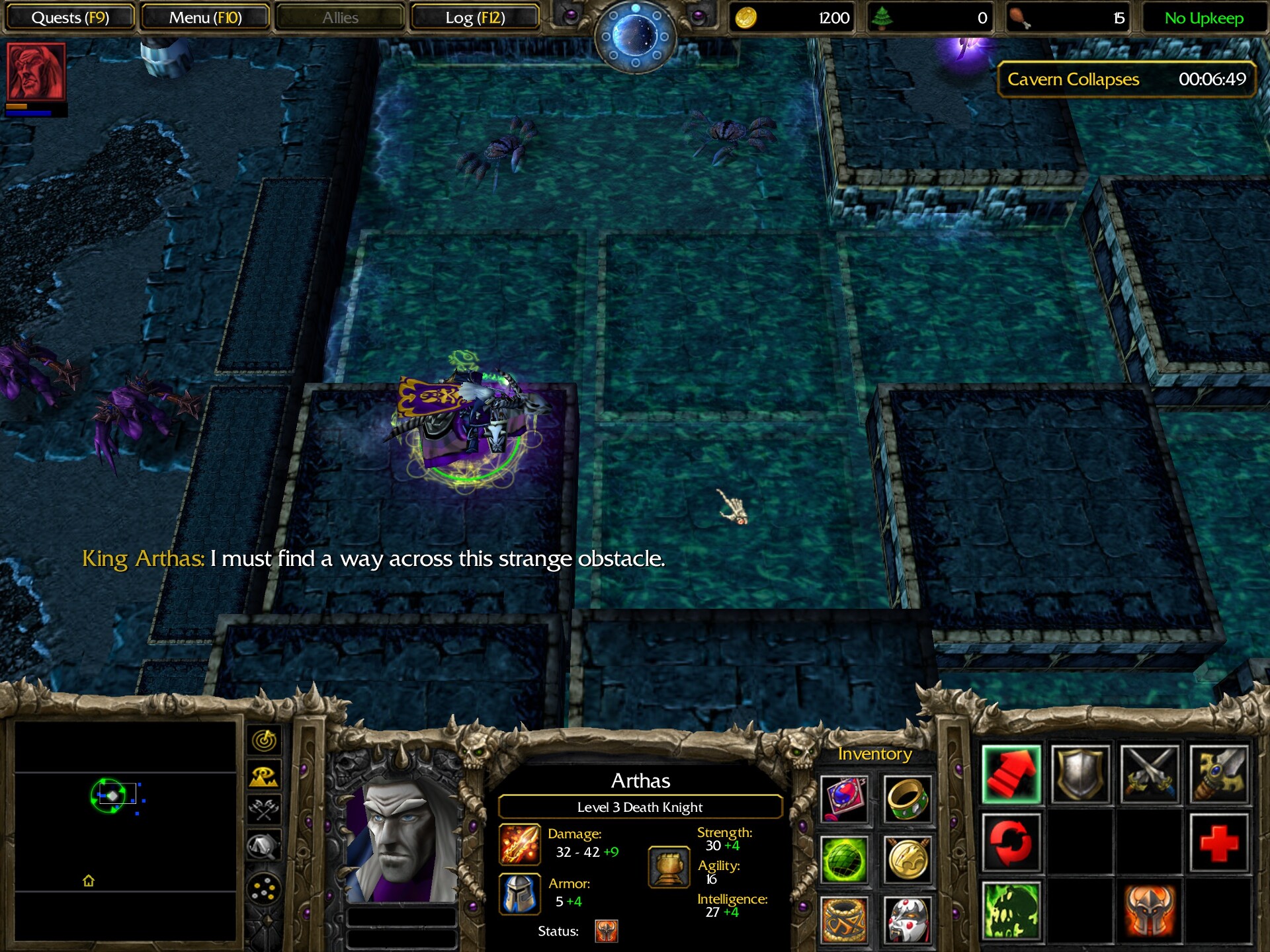
Finally, Arthas meets Anub’arak and the minions, and together they fight their way through another room full of faceless ones before the timer expires. The end.
I’ll give credit to the three Azjol-Nerub missions: though short, back at release they enticed my imagination and made me want to see and know more of the great spider kingdom beneath Northrend. I hoped that if we ever returned to Northrend in a Warcraft game, we’d get to roam Azjol-Nerub as well. Imagine my disappointment when what we got was not even a single zone but rather just two dungeons, and when we finally got a nerubian kingdom as a zone, it was not Azjol-Nerub in Northrend, but a different and unrelated kingdom on the other side of the world that the writers just suddenly made up.
Boiling Point

Arthas and Anub’arak emerge from the caverns and are immediately greeted by a Scourge army. Which was… apparently here all along, just waiting for someone to take leadership?
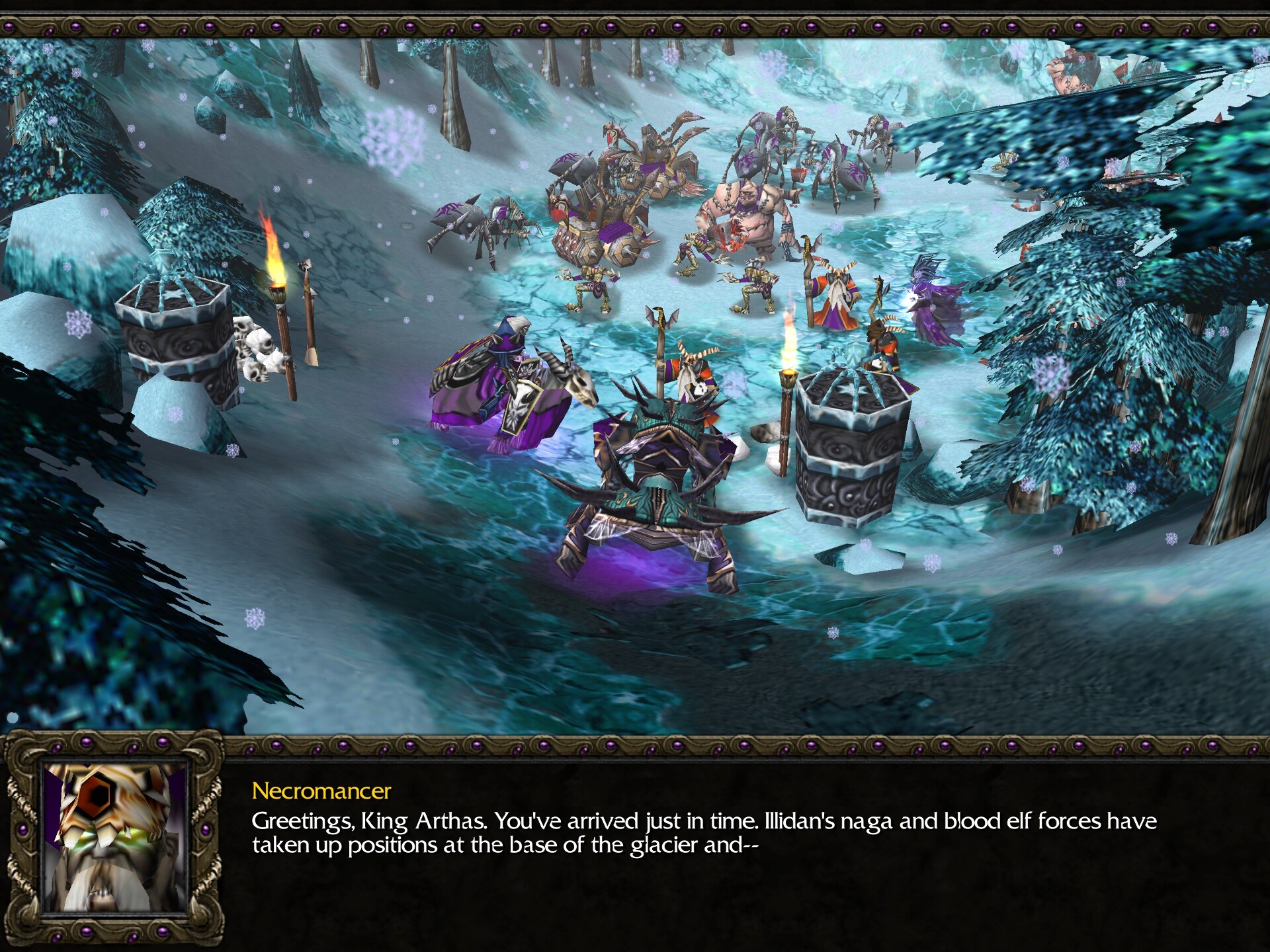
Just at this point, the Lich King chooses another moment to invade Arthas’s mind. For some reason, Arthas is surprised by this, despite having received telepathic messages from him before.
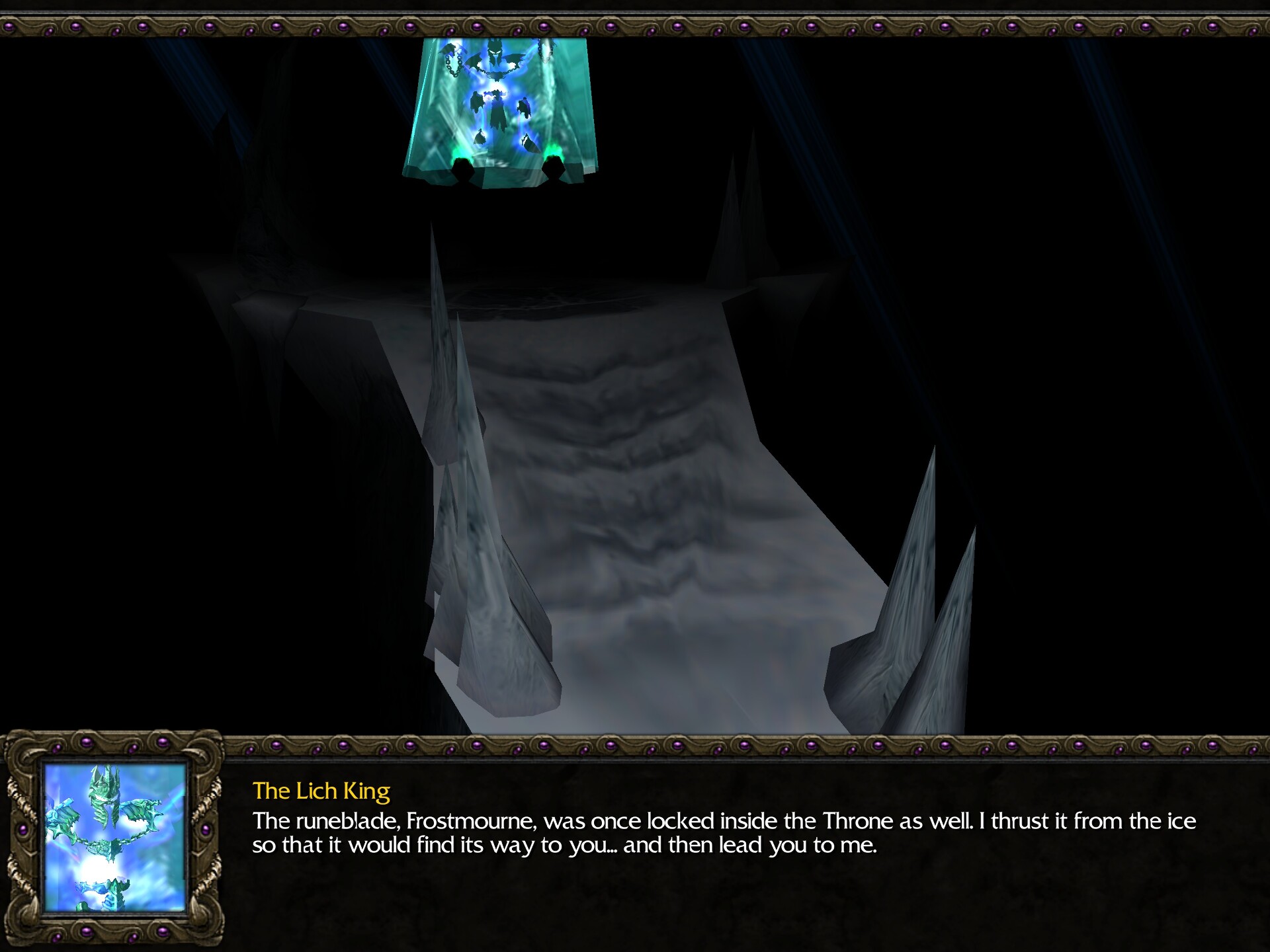
Everything has been engineered by the Lich King to bring Arthas here, but now they’re both in grave danger, as Kil’jaeden, the Lich King’s creator, sent his agents her to destroy him. He will now spare all the power he can on Arthas — which doesn’t mean that Arthas will immediately regain lost levels, but at least now his level drain will stop and he’ll be able to return from level 2 to level 10 the normal way, by gaining XP.
“It’s time to end the game… once and for all,” concludes Arthas, getting surprisingly meta. You can practically imagine him winking at the camera.
A Symphony of Frost and Flame
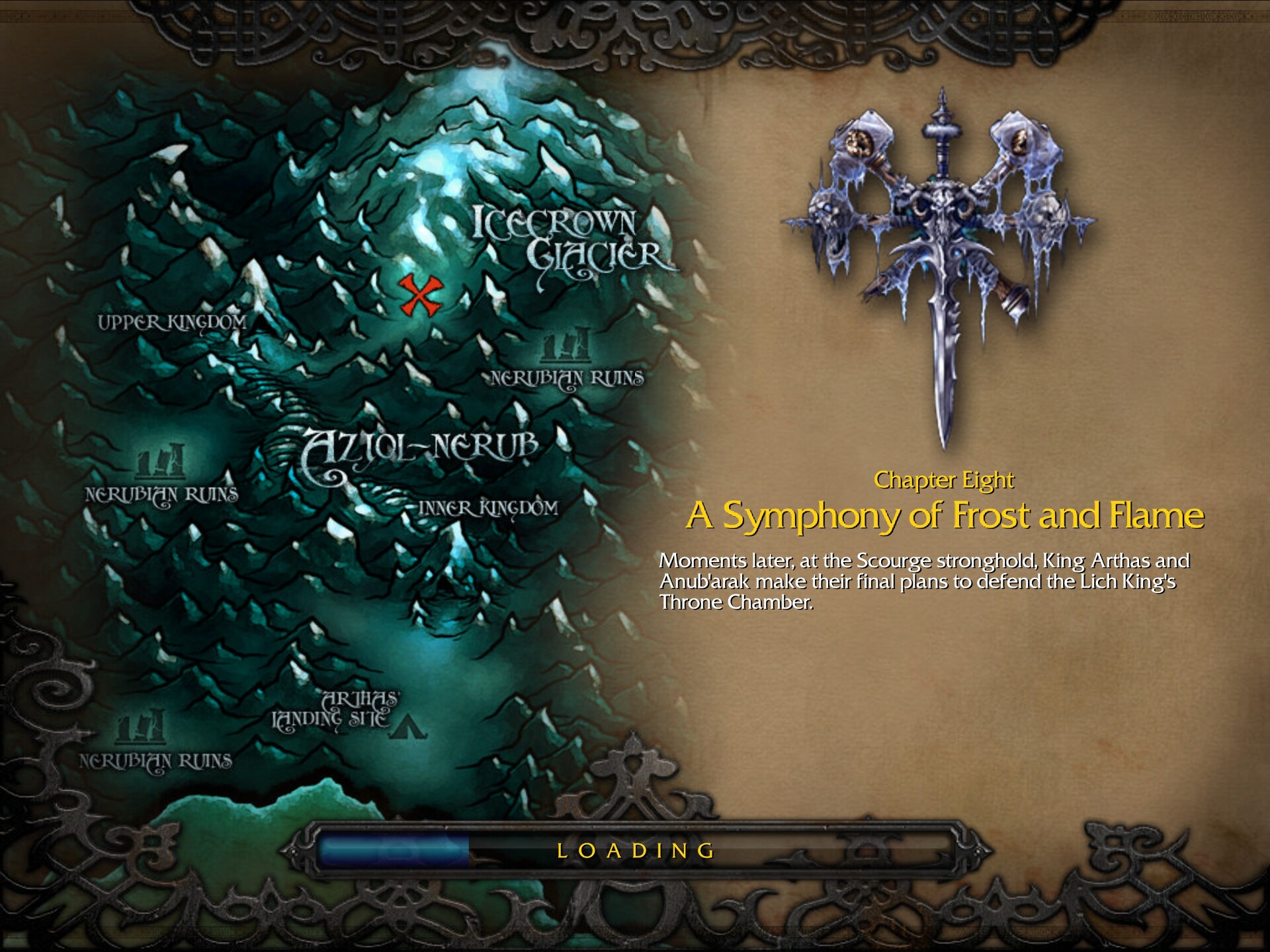
And so it comes to this. A climactic confrontation between Arthas’s Scourge and Illidan’s blood elves and naga.
Anub’arak explains our objective. It is to activate four obelisks around the hill containing the Frozen Throne, and to do it before Illidan does.

The cutscenes here don’t feature any suddenly teleporting heroes, but instead we’re back to them taunting each other across the entire map.
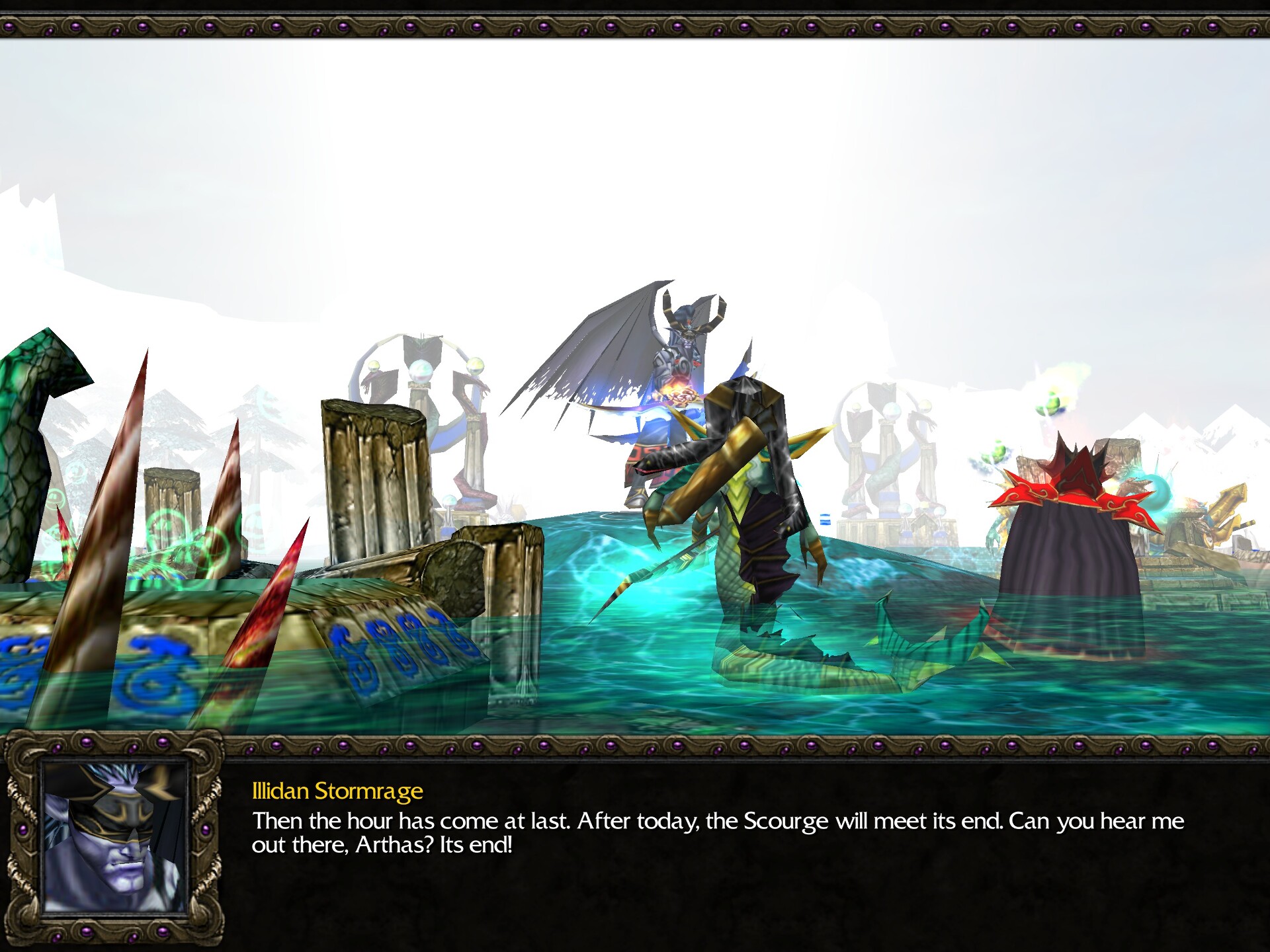
This map is fairly small, smaller than the map for the final mission of Reign of Chaos, reflecting the more personal goals. We’re no longer saving the world, we’re “only” deciding the fate of the Frozen Throne and the Scourge. And we have to build everything from scratch this time, starting with our heroes, some troops, and acolytes. Even the site for our base needs to be cleared first, as it’s occupied by a small naga base.
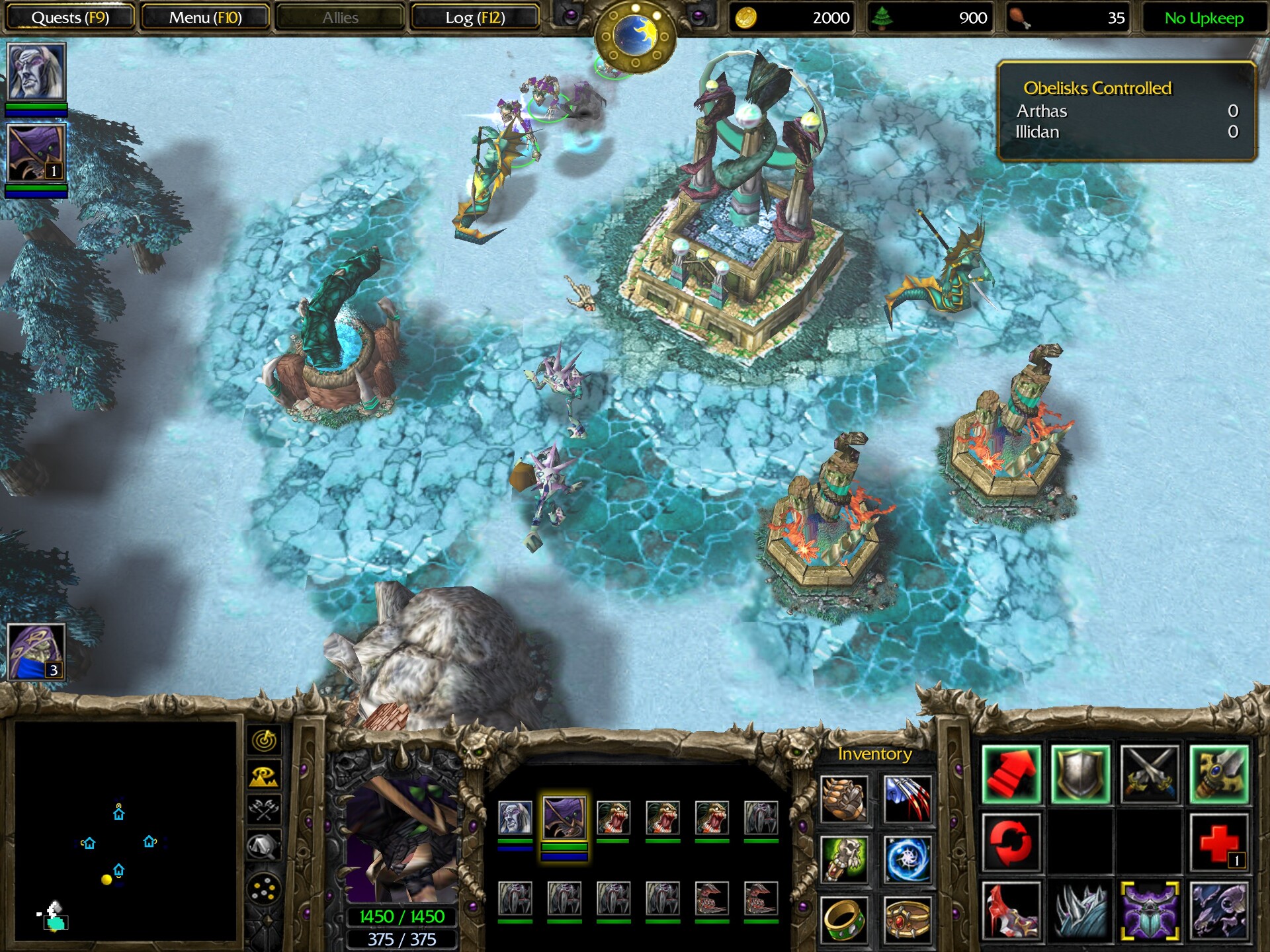
Then, and only then, can we move in our acolytes. We get a couple of sacrificial skulls to spread blight and let us construct our essential buildings without waiting for the necropolis and haunted gold mine to spread blight first, but that’s all the help we’re going to get. Now at least we have use for all that gold Arthas was obsessing over throughout the Azjol-Nerub missions: it carries into this mission, giving us a head start.
This mission, even on normal mode, really plays more like a multiplayer map than a campaign mission. Usually the pacing of campaign missions is fairly relaxed, but here we’re under constant time pressure from the very start, as Illidan isn’t even going to wait until we’re finished constructing our base, and immediately assaults the first obelisk.

Assaulting an obelisk incapacitates the hero (Arthas or Illidan) for half a minute until he finishes activating it, and when he does, the ground shakes. It was originally supposed to deal damage to enemy structures, but that was not implemented in classic Warcraft 3. It does, however, work that way in Reforged.
It really is a final exam mission, as we’re facing three heroes (Illidan, Kael and Vashj) with fully developed blood elf and naga bases.
Once, through blood and sweat and tears, we activate all four obelisks, the final cutscene plays. The path to the Frozen Throne is clear, but Illidan is blocking Arthas’s way.
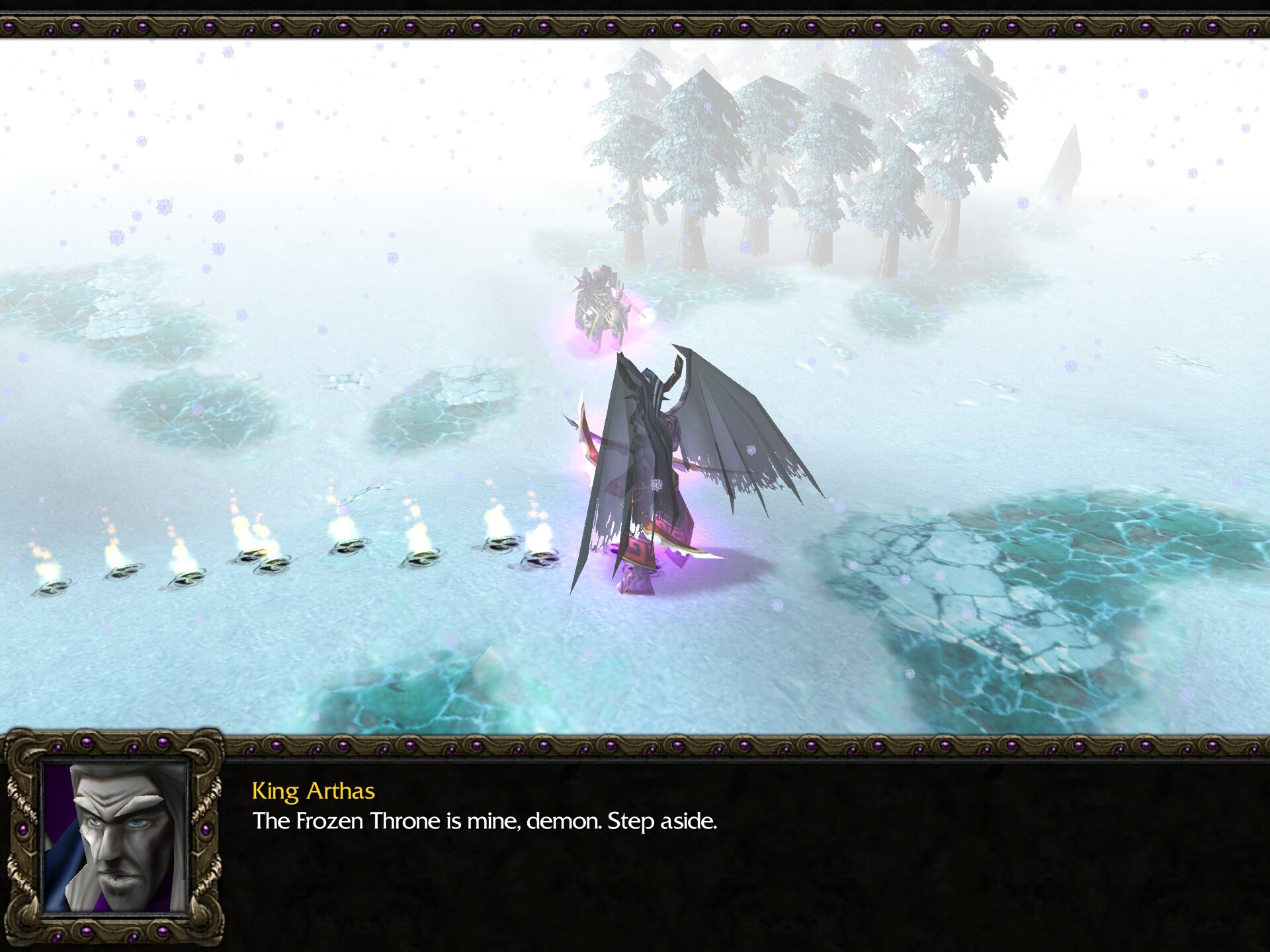
It’s time for them to fight — mano o mano.
By modern standards, this cutscene looks rather goofy. It occupies an awkward middle ground between in-mission cutscenes, which don’t even attempt any kind of realism, and photorealistic cinematics. The reason is that the fight between Arthas and Illidan was originally supposed to be a cinematic, but they ran out of time and settled for using the main menu engine instead.
Arthas leaves Illidan lying in the snow. The path to the Lich King is open.
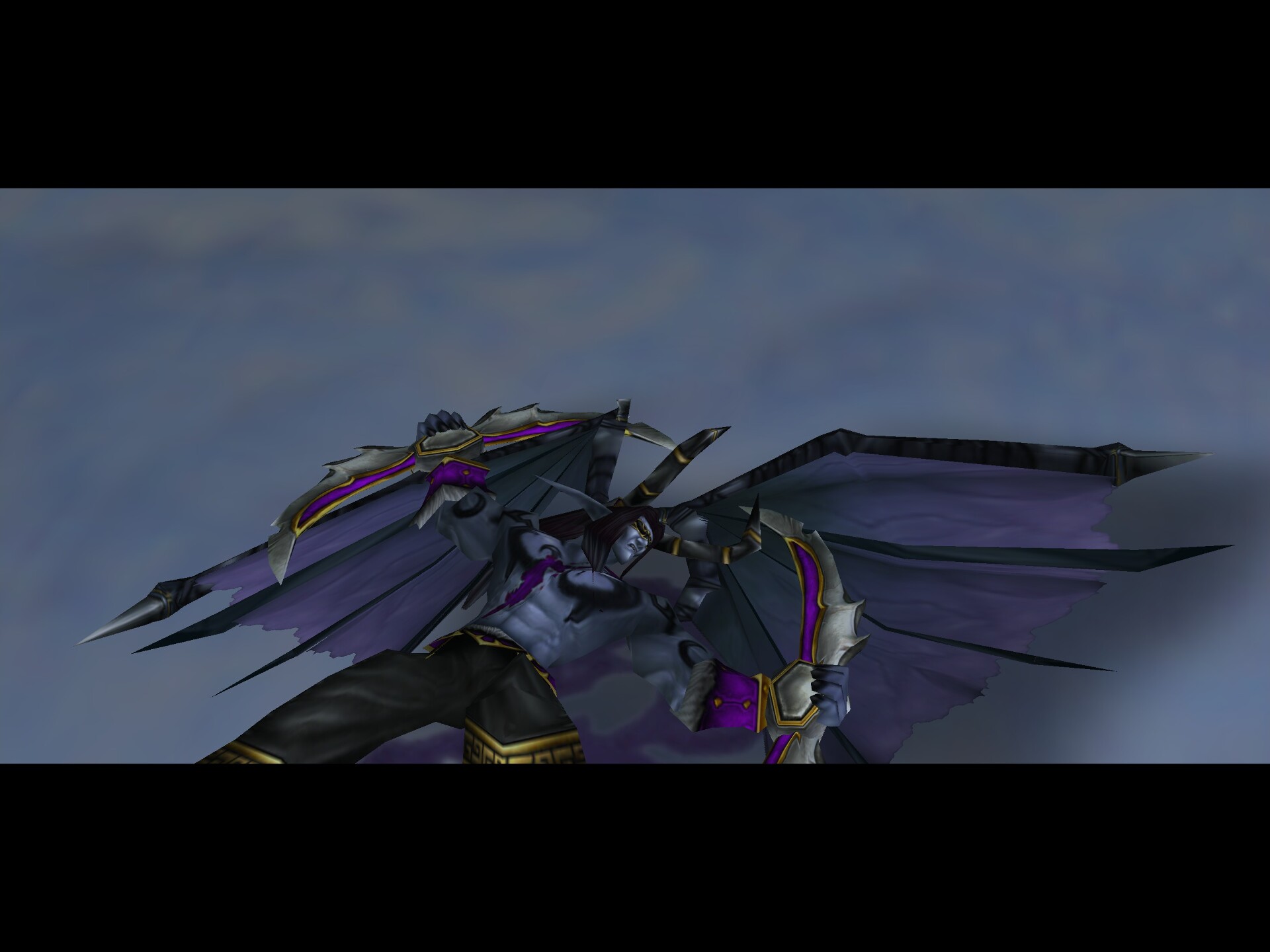
Arthas begins ascending the spiral stairs leading to the Frozen Throne. Along the way, he hears the whispers of his victims, but seemingly pays them no mind.
Reaching the Frozen Throne, he strikes, smashing the icy prison with Frostmourne. The Lich King’s helm clatters on the ground, and Arthas puts it on. As he opens his eyes, they acquire an icy glow.
“Now, we are one.”
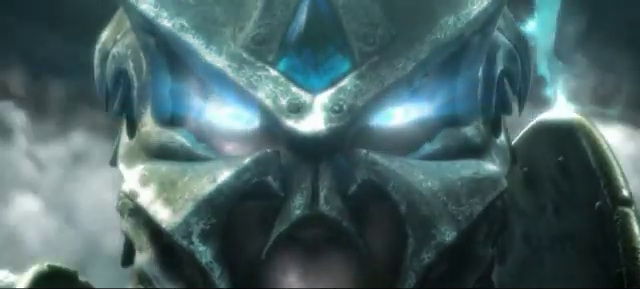
Now the Lich King is freed from his prison and has a powerful body. Is he Arthas? Is he Ner’zhul? A fusion of both? We’re welcome to speculate before World of Warcraft tells us for sure.
For now, this is the end.
Overall Thoughts
Legacy of the Damned is a campaign about evil versus evil (and versus evil). It focuses on two villain protagonists who both achieve their goal and do a lot of harm in the process. Whereas the original Warcraft 3 had a bittersweet ending (the Legion invasion was stopped, but at a great cost), The Frozen Throne has an outright downer ending Bad things happen to good people, the Lich King’s opposition is soundly beaten, and the Lich King himself, in Arthas’s body, is now stronger than ever. Whether he’s Arthas or Ner’zhul, his renewed reign is going to bide ill for Azeroth.
Narratively, The Frozen Throne is set up as a conflict between Illidan and Arthas. Both of them were very popular characters when Warcraft 3 was released, and their popularity hasn’t faded even now, twenty-two years later — which means that the Blizzard of old did something right when setting them up. I think it helps that they’re both villains with cool designs, expressive personalities, and proactivity, taking matters into their hands and paving the way for their victories instead of sitting on their thrones waiting to be defeated.
The two are foils to each other, not just because they have diametrically opposed goals (destroying the Frozen Throne versus saving it), but also because they represent different approaches to villainy. Arthas — at least death knight Arthas — is unrepentantly amoral and embraces it, committing whatever atrocities put him closer to the single goal he set in mind. Illidan was a downright anti-hero in Reign of Chaos, where he arguably did nothing wrong, but in TFT, he’s a well-intentioned extremist or at least pretends to be one; if you listen to him, then in his own words, all his evil was done for a good cause, even if it’s clear that a lot of it is self-serving, and many of the casualties (like the innocent civilians of those night elf villages) were avoidable. Point is, unlike Arthas, Illidan is uncomfortable with being seen as a bad guy.
Both characters enjoyed breakout popularity, but of course, they didn’t start with it. We didn’t come to Warcraft 3 for Arthas and Illidan; we didn’t know they existed, so we came to Warcraft 3 for the compelling story and fun gameplay, and stayed for Arthas and Illidan (and Uther, and Jaina, and Thrall, and Kael’thas, and Sylvanas…). In the time of Classic Blizzard, interesting characters were a bonus on top of everything else, stepping out of their stories and into enduring popularity, rather than a marketing gimmick to lure players in and then be discarded.
Next Up
This is it for the main storyline of The Frozen Throne, consisting of the night elf, blood elf, and undead campaigns and concerning the race between Arthas and Illidan for the titular Frozen Throne.
However, the expansion still has one story left to tell. The Horde has a side campaign of its own, completely unrelated to the main plot and instead focusing on the orcs settling in Kalimdor, and the challenges they face as they carve a piece of land for themselves.
Prepare for The Founding of Durotar, a campaign unlike any other — one that plays less like an RTS and more like a mini-RPG!
Screenshot from the webcomic Concerned: The Half-Life and Death of Gordon Frohman by Christopher C. Livingston.
-
Or, for that matter, what they do with all the waste. ↩
-
Actual crabs, not placeholders for spiders from an arachnophobia switch. ↩
-
Maybe the Forgotten One was a load-bearing boss? ↩
Leave a Comment